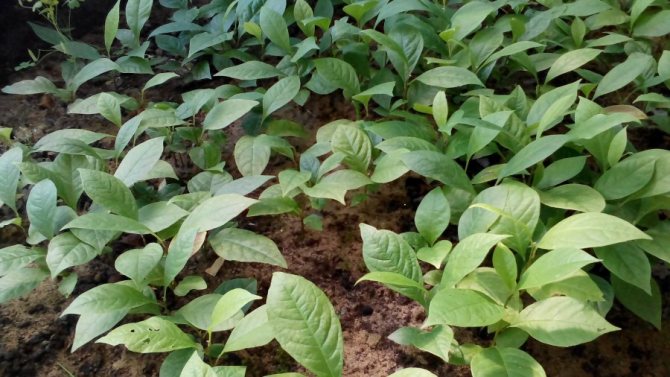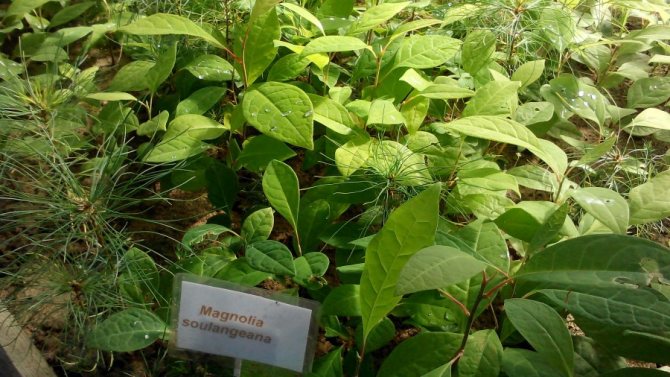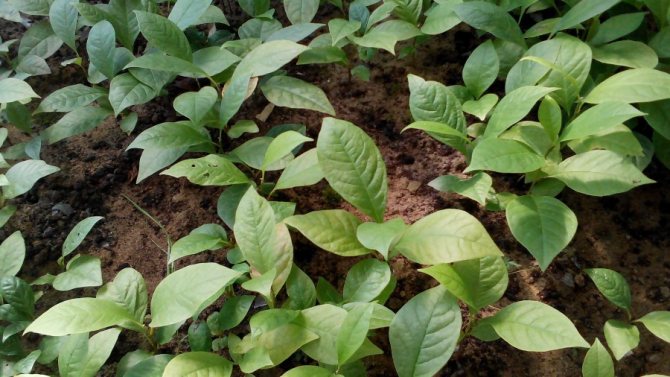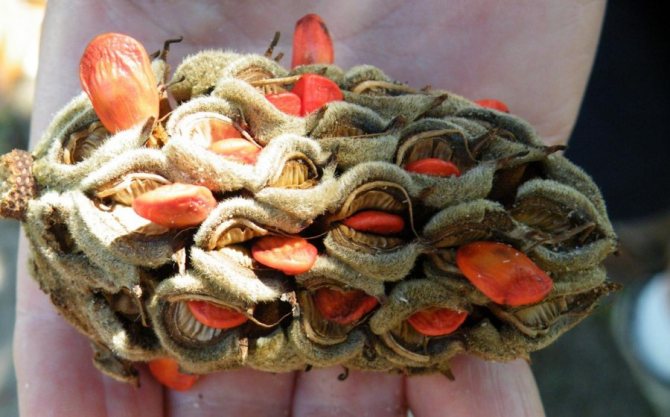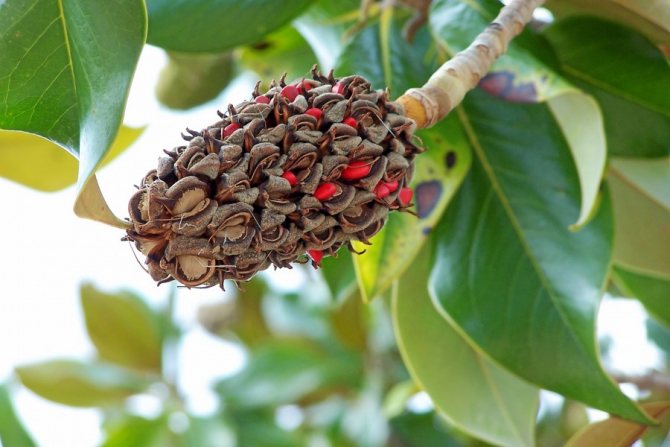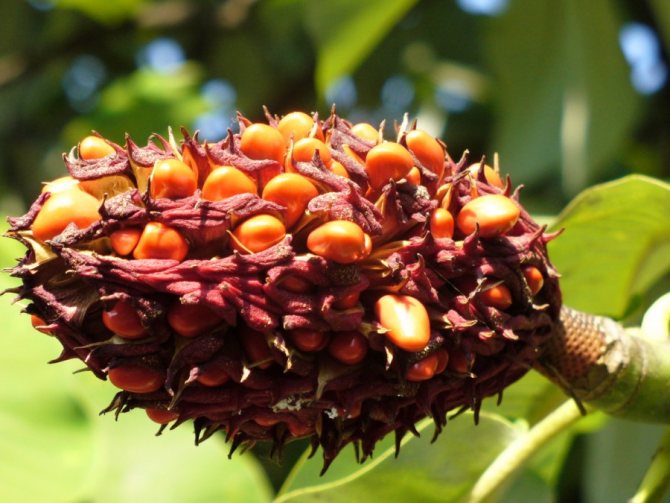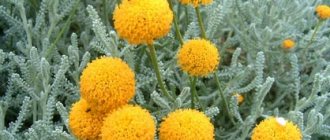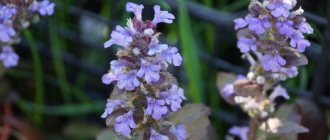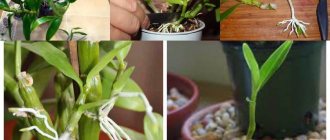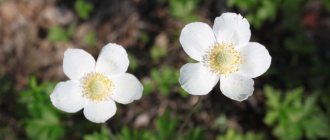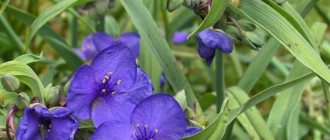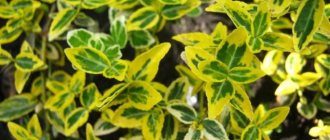The flowering plant Magnolia is a member of the magnoliaceae family. This genus unites more than 200 species. For the first time, these plants appeared in Europe in 1688, and named this genus Magnolia C. Plumier in 1703 in honor of Pierre Magnol, who was a botanist. In nature, these plants can be found in regions with subtropical and tropical climates of North America and East Asia. Magnolia is a very ancient plant of the dinosaur era, which spread during the Cretaceous and Tertiary periods. Archaeologists have found a petrified flower of this plant, which is at least 95 million years old. Magnolia was able to survive mainly because it relatively easily and quickly adapts to changeable climatic conditions. In ancient times, bees did not exist yet, and pollination of this flowering plant took place with the help of beetles, which at the moment have retained this ability.
One very beautiful and sad legend is connected with magnolia. The Japanese girl Keiko made beautiful paper flowers for sale, but this work brought her mere pennies, since the flowers were not real. Once, one parrot, whom Keiko sometimes fed, revealed a secret to her: paper flowers can become alive, but for this they need to be watered with a drop of their own blood. But it should be borne in mind that this drop should not be the last. Keiko took advantage of this secret and soon became rich, but the man she fell in love with was so greedy that he forced the girl to work all day long so that he had even more money. And then the moment came when the girl watered the paper flower with the last drop of blood and died. The flower that came to life thanks to this drop was called magnolia. Since that time, the magnolia flower has become a symbol of generosity and nobility of the soul.
Magnolia: planting and care in the open field
Everyone who has seen a magnolia at least once in his life immediately begins to dream of a wonderful flowering tree near his home. It doesn't matter where the acquaintance took place - on the Black Sea coast or in the botanical garden - huge white, red or pale pink magnolia flowers leave an indelible mark on the soul of any person. Do we have a chance to transform fairytale dreams into reality? Let's figure it out.
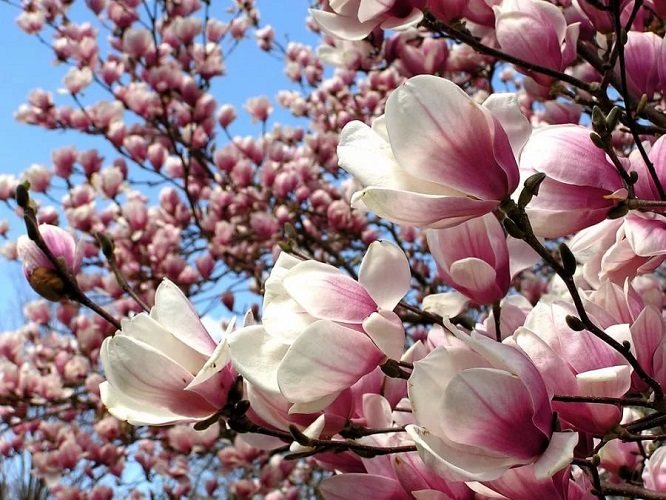
Magnolia disease
Magnolias practically do not get sick, but sometimes gardeners make mistakes when growing this plant.
- In case of an overdose of fertilizer, the magnolia stops growing and the salinity of the soil around the plant increases. The leaves begin to dry out in the summer. All this can be corrected by watering the tree with very abundant warm water every seven days.
- In hot weather, a spider mite can attack the tree. You need to fight him with actellik, spilling earth with it and spraying a tree. If you do not carry out processing, the tree will dry out.
- If there is a lot of lime in the soil, then the roots of magnolia begin to ache and a disease called chlorosis appears on the leaves. In such soil, magnolia can live no more than one year. Therefore, if there is calcareous soil on the site, then the only way out, digging a hole for planting, replace the unnecessary soil with fertile one.
- Insufficient watering leads to the death of the plant, so additional watering is required during the heat in summer.
Choosing a place to plant magnolias
The landing site is determined in advance, given that magnolia:
- prefers areas protected from winds and drafts;
- absolutely does not tolerate heavily limed soils: roots hardly develop in them and may die. If the soil in your area is exactly like this, mix it with acidic peat, this will lower the pH;
- grows poorly on heavy, waterlogged and sandy soils.
The best place for planting will be sunny, in the southern regions - a slightly shaded area with light fertile soil.
Magnolia lily (M. liliflora)
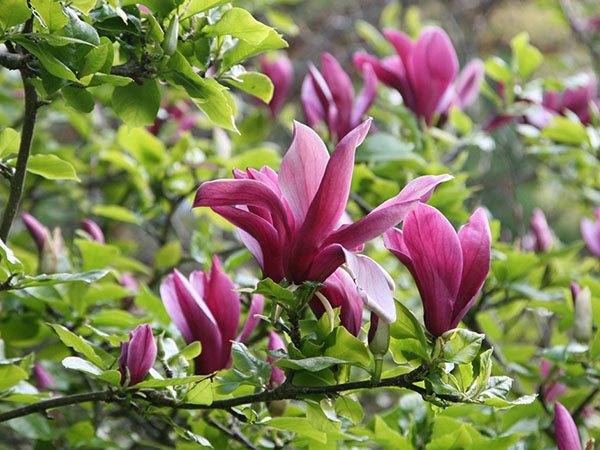

In the gardens of China and other countries of the region, you can find the lily magnolia, so named due to the original shape of the corollas. The plant is actively used for hybridization and decorative forms.
One of them is the most popular in Europe and Russia. This is the magnolia nigra (M. liliflora f. Nigra) shown in the photo with purple flowers. Outside, the color of the petals is dark, inside the corolla looks pink.
Planting magnolias outdoors
Regarding the timing of planting, most gardeners agree that it is better to plant magnolia in the fall, when young seedlings have already stopped growing, as if "falling into hibernation." Autumn planting should be done in mid-late October, when there are no severe frosts yet, and the unbearable heat is gone. Opinions differed regarding the spring planting. Some gardeners believe that young magnolia saplings, like most trees, can be planted in the spring - in April. The latter insist that even small return frosts can cause irreparable harm to trees that have already begun to grow, after which rehabilitation will be long and, most likely, ineffective. With spring planting, active growth begins, the seedling gives a large increase and often enters the winter with shoots that have not had time to lignify. This leads to their death in winter.
To listen to such conflicting opinions or not is up to you. But think about whether the risk is justified: after all, a seedling correctly planted in the fall will take almost 100% of its roots. Before you start planting a magnolia, you need to choose the right seedling: it must have a closed root system. It is very important that the roots of the seedling do not dry out before planting. Therefore, it is recommended to buy a magnolia sapling in a container. Such a plant is easier to transplant into open ground, because it is planted with a clod of earth.
Container-grown magnolia can be planted outdoors throughout the warm season. But it is better to give preference to autumn planting when the plant is at rest. Choose a seedling with flower buds, they are easy to distinguish by their appearance.
Young plants are planted in partial shade immediately to a permanent place. Magnolia doesn't like transplants.
A distance of 4-5 m is maintained between magnolias, and with a limited area of \ u200b \ u200bthe plot, they are planted in groups of 3-4 plants: one tree magnolia, and around it - 3-4 bush.
Transplant features
The root system reacts extremely negatively to all damage and therefore it is worth being especially careful (use the transshipment method). You do not need to shake the plant hard to brush away the remnants of the earth - it is important to gently and calmly knead the lumps with your hands.
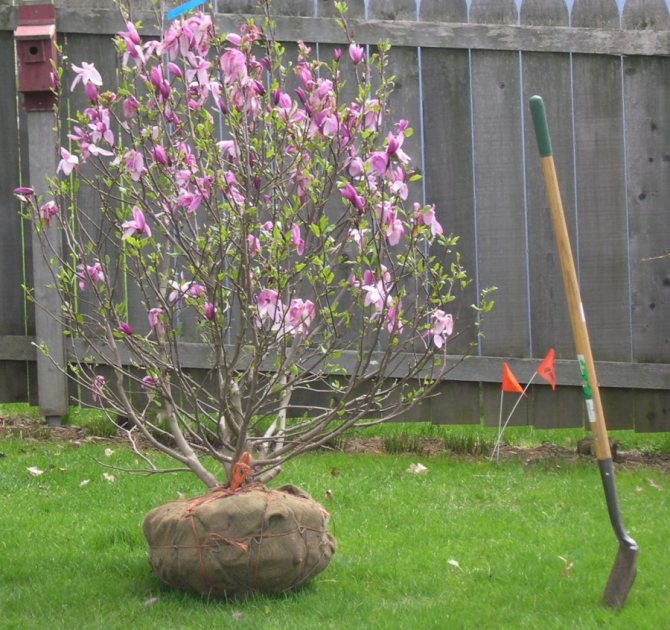

Magnolia requires a lot of land, so choose the largest pots. The root system is well developed, which allows the plant to be resistant to natural droughts, since the roots provide the necessary nutrients from the soil.
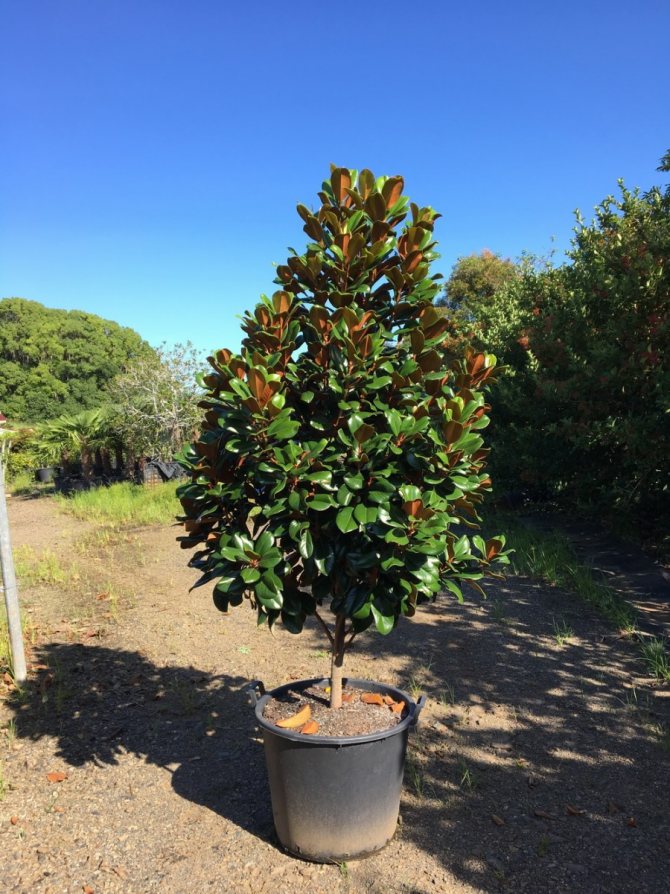

Magnolia care
Magnolias are not demanding to care for. It must be remembered that in the wild, magnolias grow in climates with dry and warm autumn and humid summer. Mandatory measures include regular watering in a drought, the introduction of complex organic and mineral fertilizers. For a young plant (up to 5 years old), watering is needed once a week.About 20-30 liters of water, but if the summer is dry, the plants will be happy to increase the watering by two or three times. In a rainy summer, you can water much less often. If the soil is sandy, water more often.
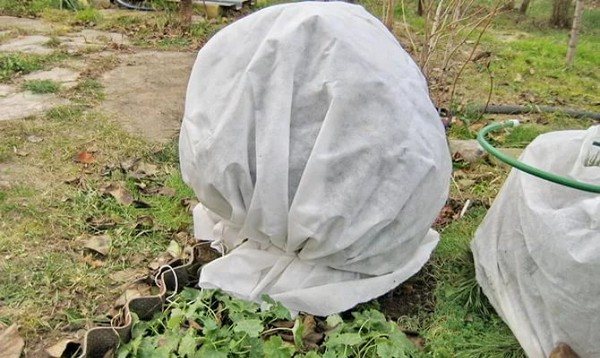

Adult magnolia plants can withstand freezing temperatures of 25-30 ° C, but young specimens should be covered. Usually, a two-layer nonwoven fabric such as lutrasil or burlap is used. In especially harsh winters, it would be nice to shelter adult specimens. Magnolia branches are very fragile, so be careful when tying them in bunches for cover. Of particular danger to northern magnolias are frequent winter thaws, during which the plant can begin to open its buds, and recurrent frosts can easily destroy nascent beauty. In the fall, mulch the root system with pine bark, foliage, peat or spruce branches. Top dressing must be completed at the beginning of August in order to allow the shoots to ripen, then they will not be damaged by frost. In winter, to protect against rodents, the trunks must be wrapped in non-woven fabric or a special net.


Many types of magnolia grow in the form of a bush or multi-stem tree in the early years of cultivation, so pruning off excess shoots will give them the desired tree shape. In the future, formative pruning is not needed for magnolias, so they will bloom much better. Even anti-aging pruning will not be beneficial - the plant will regain its former beauty for too long, because dormant buds on old branches bloom extremely inactively. Therefore, you should limit yourself to annual sanitary pruning.
Types and varieties of magnolia with photos and names
The largest collections of magnolias are found in the UK, namely at the Royal Botanic Gardens and at the Arnold Arboretum introduction center. There is also a fairly beautiful collection in Kiev. The species most popular with gardeners will be described below.
Magnolia sieboldii
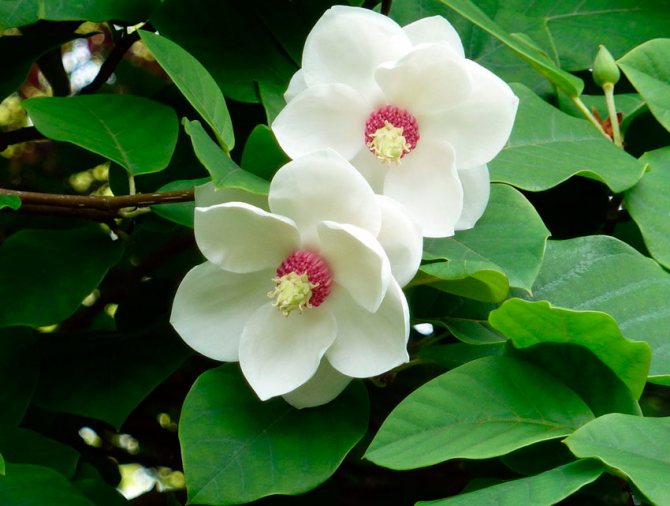

The height of such a deciduous tree is about 10 meters. However, most often this species is represented by a shrub. Its leaf plates are broadly elliptical, and they reach 15 centimeters in length. On a thin pubescent peduncle there is a slightly drooping fragrant white cup-shaped flower. Flowers in diameter can reach 7-10 centimeters. This species is one of the most winter-hardy, it is able to withstand short frosts down to minus 36 degrees. Cultivated since 1865
Magnolia obovate (Magnolia obovata), or white magnolia
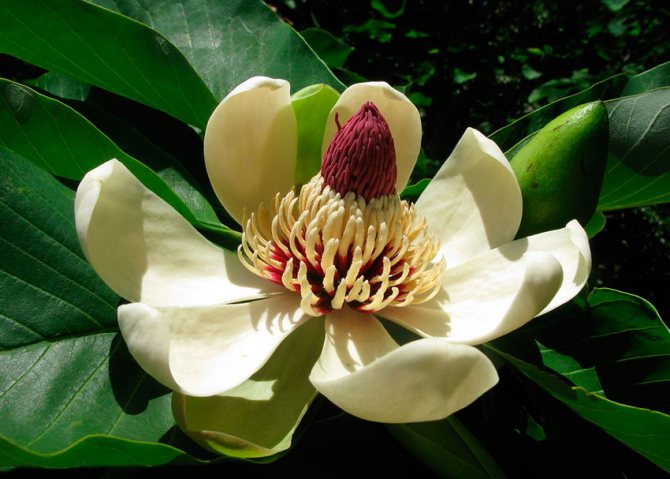

This species comes from Japan and from the island of Kunashir, which is located in the Kuril Islands. The height of this deciduous tree is about 15 meters. The color of the smooth bark is gray. At the ends of the stems, 8–10 leaf plates are collected. The diameter of the spectacular cream-white flowers is about 16 centimeters, they are distinguished by the fact that they have a spicy scent. The length of the rich red fruit is about 20 centimeters. Such a plant looks spectacular all year round, it is shade-tolerant and frost-resistant, but at the same time it is demanding on the level of humidity in the air and soil. Cultivated since 1865
Magnolia officinalis (Magnolia officinalis)


The homeland of this species is China. This plant is considered an analogue of medicinal magnolia, but its leaf plates are larger. The large, fragrant flowers are superficially similar to water lilies, but they have narrower petals that taper towards the top. At home, this species is used as a medicinal plant, and in middle latitudes it can be found extremely rarely.
Magnolia pointed (Magnolia acuminata), or cucumber magnolia
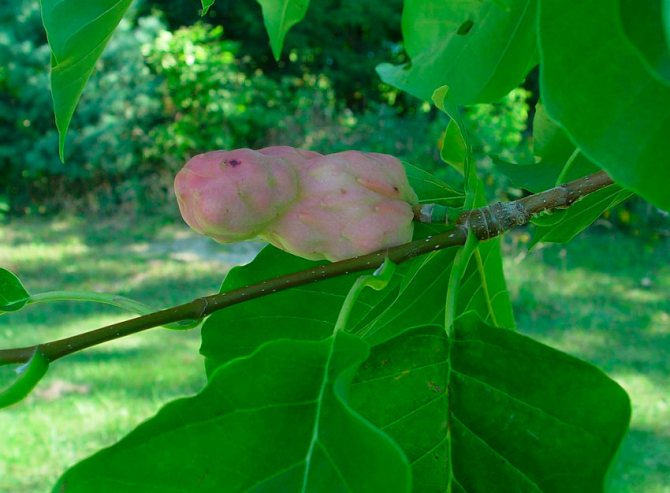

This plant comes from central North America. Under natural conditions, it prefers to grow in deciduous forests at the mountain foot, as well as along the rocky banks of mountain rivers. This deciduous tree can reach a height of about 30 meters.In a young plant, the crown shape is pyramidal, but it gradually becomes rounded. Elliptical or oval leaf plates reach 24 centimeters in length. Their front side is colored dark green, and the back side is greenish-gray, there is a short pubescence on its surface. The diameter of the bell-shaped flowers is about 8 centimeters, they are colored greenish-yellow, in some cases there is a bluish bloom on the surface. This species is the most frost-resistant of all. This species has a shape with rounded or heart-shaped leaf plates at the base. Canary-colored flowers are not as large as those of the main species. In the United States, specialists obtained hybrid magnolias by crossing the lily-flowered magnolia and the pointed magnolia, they are combined under the name of Brooklyn magnolia.
Magnolia stellata
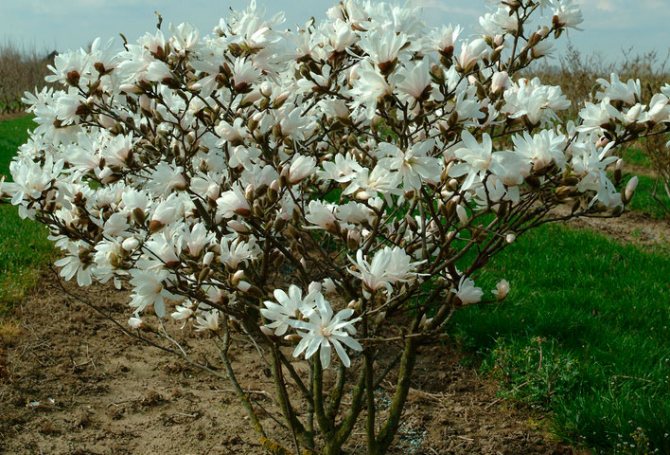

This type is one of the most beautiful and graceful. He comes from Japan. The plant is a shrub or not a very large tree, the height of which can reach 250 centimeters. Branches are bare, brownish-gray in color. The shape of the leaf plates is narrowly elliptical, their length is about 12 centimeters. The diameter of the unusual flowers is about 10 centimeters, they have a large number of snow-white petals of an elongated ribbon-like shape, they extend in all directions, which is similar to the rays of a star. There are 2 decorative forms: Keyskaya and also pink. Several varieties and hybrids are also popular with gardeners. For example, Susan's magnolia is a cultivar that has flowers that have a dark reddish crimson outside and a paler color on the inside. This variety is part of a series of hybrids with female names: Betty, Pinky, Jane, Judy, Anna, Randy and Ricky. This series was born in the fifties of the last century.
Magnolia liliflora
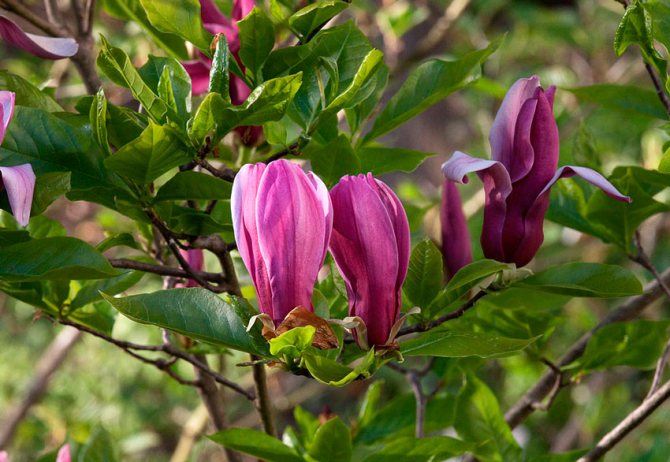

This species is very popular with gardeners. Presumably, the homeland of such a plant is eastern China, in Europe it appeared in 1790. The flowering is lush, the diameter of the flowers with a subtle smell is about 11 centimeters, they are very similar in shape to a lily. Their inner surface is white, and the outer one is purple. The decorative form of this type of Nigra (Nigra) deserves special attention: the outer surface of its flowers is ruby-red, and the inner one is lilac-white, flowering begins in the last days of April or the first days of May.
Magnolia kobus
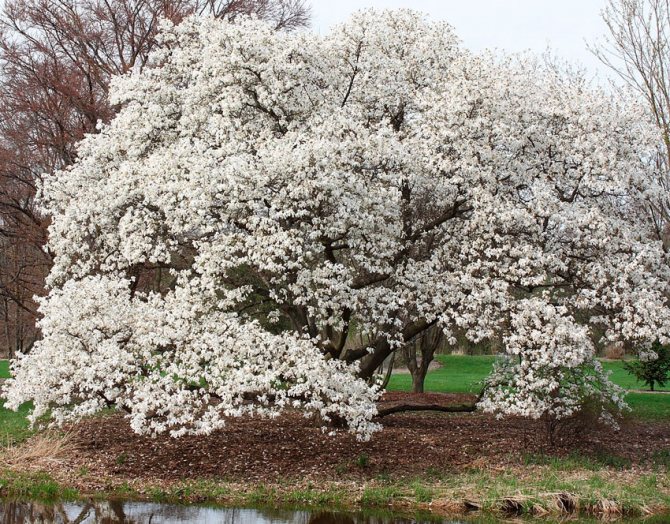

The homeland of such a plant is South Korea, as well as central and northern Japan. It got to New York in 1862, and from there it was brought to Europe in 1879. Under natural conditions, the height of a tree can be 25 meters, but in culture it does not exceed 10 meters. Wide leaf plates of obovate shape have a pointed apex. Their front surface is deep green, and the back is painted in a paler shade. The diameter of the fragrant white flowers is about 10 centimeters. The first flowering of such a magnolia can be seen only when it turns 9-12 years old. This type is frost, dust and gas resistant. The northern form is a plant with larger flowers, which is even more hardy.
Magnolia grandiflora (Magnolia grandiflora)
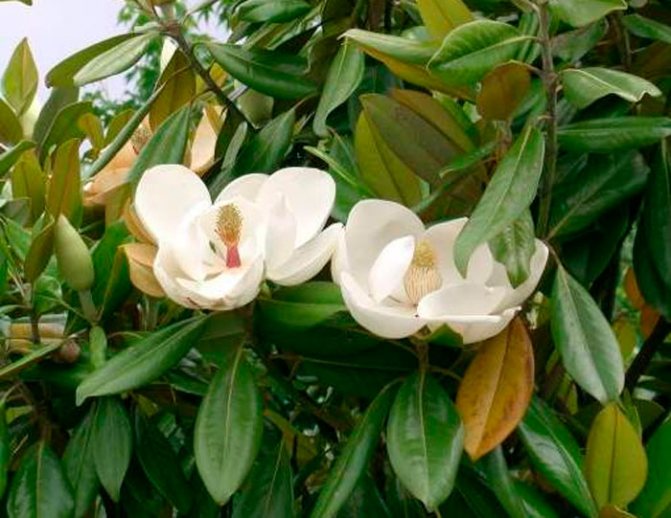

Originally from the southeast of North America. The slender barrel has a cylindrical shape. Crohn has a very effective shape. The color of large glossy leaf plates is dark green. The diameter of the white flowers is about 25 centimeters, they have a pungent spicy scent. The fruits are also highly decorative, they are very bright and have a cone-like shape. While the plant is young, it is characterized by slow growth, so the annual growth is only 0.6 m. It has low winter hardiness, it can withstand frosts of at least minus 15 degrees.This species grows well in urban conditions, it is durable and highly resistant to pests and diseases. Basic decorative forms:
- Narrow-leaved... The leaf plates are narrower in comparison with the main view.
- Lanceolate. The foliage is elongated.
- Famous... The leaf plates are very wide, and the flowers are about 0.35 m in diameter.
- Round-leaved... The leaf plates are colored very dark green. The diameter of the flowers is about 15 centimeters.
- Early... Flowering begins earlier than the main species.
- Exon... This tall tree has a narrow pyramidal crown shape. The leaf plates are oblong and have pubescence on the lower surface.
- Do it... The crown shape is strictly pyramidal.
- Hartvis... The shape of the crown is pyramidal, foliage is wavy.
- Draconic... The crown is lowered very low. Arcuate hanging branches touch the ground and take root quickly.
- Gallison... Has greater frost resistance compared to the main species.
Magnolia Sulange (Magnolia x soulangeana)
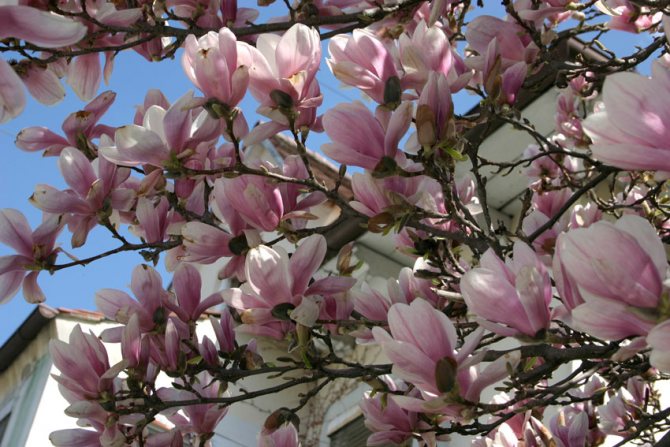

This hybrid was born in 1820 thanks to the Frenchman E. Soulange, who was a scientist. At the moment, more than 50 forms of such a hybrid have been registered, and all of them are very popular in almost every country. The height of such a deciduous shrub or tree does not exceed 5 meters. The length of obovate leaf plates is about 15 centimeters. The diameter of the goblet flowers can vary from 15 to 25 centimeters, they are fragrant, and in some cases they have no smell at all. They can be painted in various shades from purple to light pink. A plant with white flowers is extremely rare to see. This magnolia is resistant to adverse environmental influences and is not demanding on the composition of the soil. The most popular garden forms:
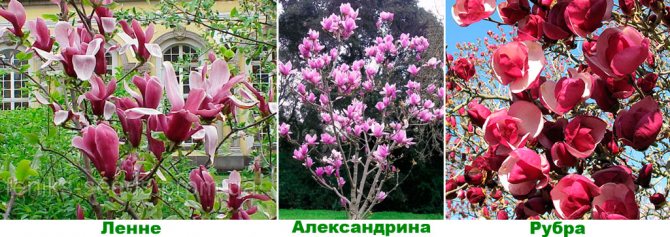

- Lenne... The inner surface of the fragrant flowers is white, while the outer surface is purplish pink.
- Alexandrina... The magnolia is about 8 meters high and is drought tolerant. The outer surface of the flowers is dark purple and the inner one is white.
- Rubra (red)... The outer surface of the flowers is reddish-pinkish.
- Nemetsa... The shape of the crown is pyramidal.
Also, this hybrid has a large number of varieties.
In addition to the species described above, gardeners cultivate willow, large-leaved, Lebner's, nude, three-petalled, or umbrella magnolia, etc.
Reproduction of magnolia
The oriental beauty simply reproduces quite simply, so if you have access to an adult tree, you can easily get planting material. Magnolias are planted, cut and cut. Extremists and true connoisseurs grow the beauty from seeds. If you nevertheless took a chance and decided to stock up on magnolia seeds, then keep in mind that you need to sow them in the fall, without delay. The best time is after the berries have been picked. Storing seeds is a complex process; a beginner is practically unable to cope with it. Prepared seeds are suitable for sowing. To this end, it is worth removing the shell from them. This is done with a cut. The next stage in preparing seeds for sowing is washing them. It is necessary in order to remove the oily layer from the surface of the seed. It is usually washed with a mild soapy solution and then rinsed in clean water. Only after the seeds are prepared can they be sown.


The best seed germination medium is a versatile substrate. Close the seed to a depth of 3 cm and put it in a cool, dark place before spring comes. From the first days of spring, the boxes are taken out in the sun. They are usually installed on a windowsill. From time to time it is necessary to water the soil, preventing it from drying out. Do not expect rapid growth from seedlings. Under the most favorable conditions, your seedling will not grow more than 50 cm. Only one-year-old sprouts are planted in a permanent place. The easiest way to reproduce an oriental beauty is layering.It's easy to get them: you just have to bend the lowest branch to the ground, fixing it in this position. Sprinkle earth on the branch. Unfortunately, the disadvantage of this method is the long waiting time for layering - it takes 2 years for the roots to appear. Cutting is as easy to do as cutting. However, cuttings successfully take root only in greenhouses. The best option is a mini-greenhouse with the function of regulating temperature and humidity of air and soil. Cuttings are harvested at the end of June, when magnolia has a peak in growth. It is better to harvest from a young tree. There should be 2-3 leaves at the top of the cutting. To speed up the process of root formation, it is better to treat the lower part with a special stimulant. The prepared stalk must be planted in sand; it is permissible to use a mixture of sand with perlite. Next, you should make sure that the substrate is moist. It is important to observe the temperature regime. The best temperature range for germination of magnolia cuttings is 19-22 degrees. It is also worth covering the handle with a lid. Failure to comply with the conditions will lead to the death of the harvested planting material. It takes up to 2 months on average before rooting. Only rare varieties, including large-flowered, require 4 months. One-year-old seedlings are planted in a permanent place.
Malicious factors
Among the harmful ones are rodents and moles. Some gnaw the root system, others bury them. Lubricate the damaged areas with a 1% solution of foundation.
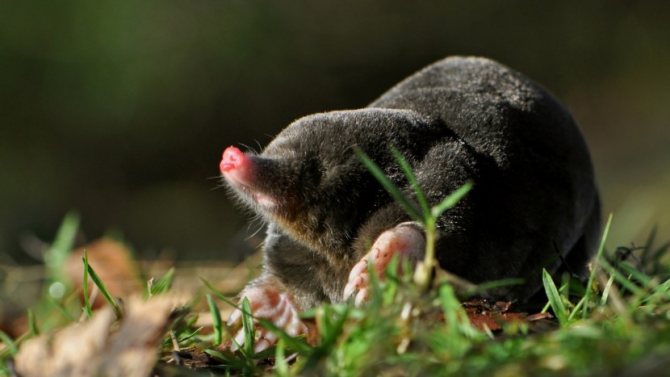

Spider mites are dangerous in hot, dry weather. It absorbs the juice of the leaves, causing them to die off completely.
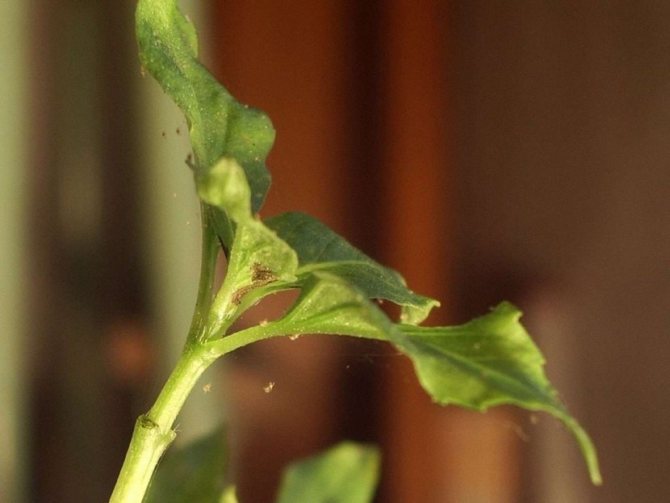

Magnolia Pest and Disease Control
- Magnolia is rarely prone to disease. Improper care can cause some unpleasant phenomena.
- The appearance of yellow spots on the leaves indicates a lack of iron and the manifestation of chlorosis. This is due to the increased lime content in the soil. It is imperative to increase the acidity level of the soil, and treat the plant itself with an iron chelate solution.
- An overdose of fertilizers causes salinization of the soil and, as a result, the leaves begin to dry out, and the plant slows down growth and development. In such cases, it is necessary to introduce frequent watering, thus reducing the concentration of the fertilizer introduced.
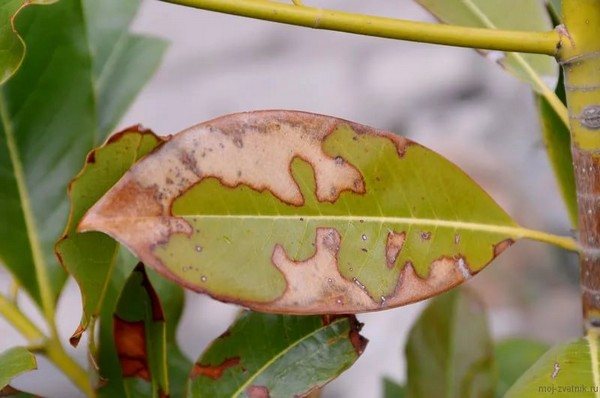

- To get rid of diseases such as anthracnose (spotting) or powdery mildew, the plant is treated with appropriate fungicides (Maxim, Switch, Skor, etc.).
- Of the pests, magnolia can be attacked by a spider mite that feeds on the sap of the plant's foliage. Affected leaves fall off and the plant weakens.
- Rodents often damage the roots and shoots of the plant. In case of noticeable damage, the wounds are treated with a 1% solution of foundationol, and the rodents are exterminated (traps are prepared, poison is laid out).
- As a preventive measure, magnolia is sprayed in early spring with paraffin oil or any insecticide (Aktara, Aktellik), destroying pests and their larvae in advance.
What kind of lighting should it be?
Due to its unpretentiousness, magnolia easily tolerates partial shade and too dry air. But for good growth and flowering, the plant simply needs bright lighting. If the pot is located in the room, it must be placed by the window.
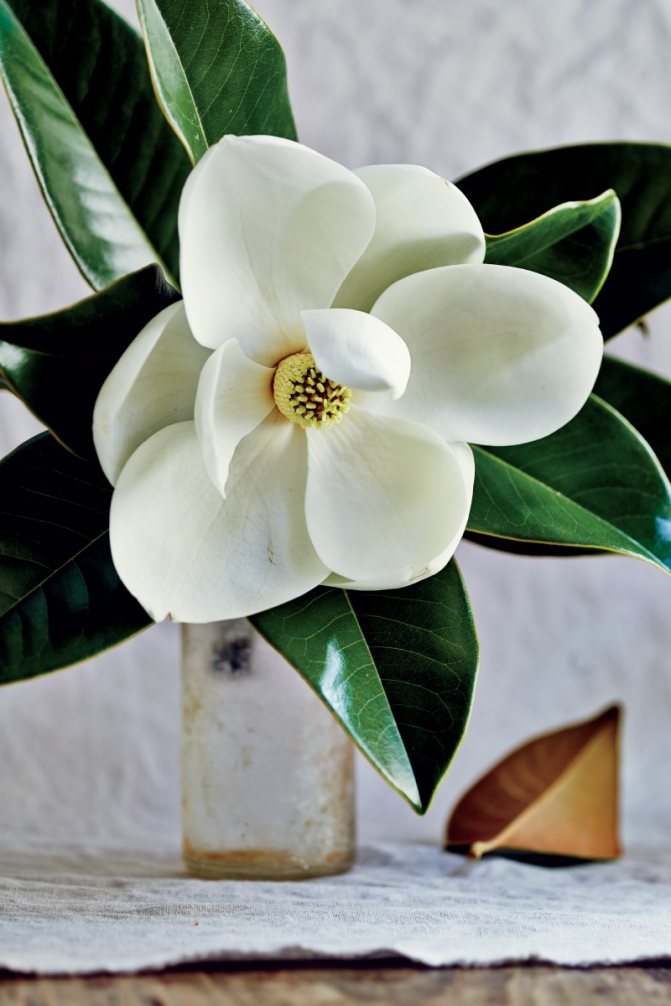

Even in the garden, magnolia is planted away from large plants so that the maximum amount of light falls on it.
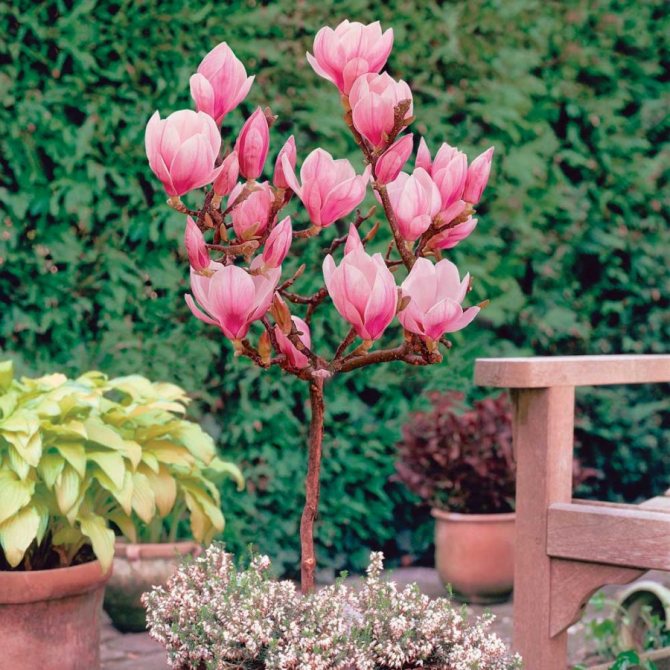

How to grow a magnolia in the middle lane - all about planting, care and wintering
Adding an article to a new collection
Many people find this thermophilic plant very difficult to care for. But this is not entirely fair. Magnolia can be successfully grown in the middle lane and even wait for a spectacular flowering. What do you need to know for this?
The first step is to select a quality seedling of a suitable variety, since not all magnolias thrive in unstable temperate climates. And then - it's up to the little. Just take into account the peculiarities of caring for magnolia and provide it with a comfortable winter.
Willow Magnolia (M.salicifolia)
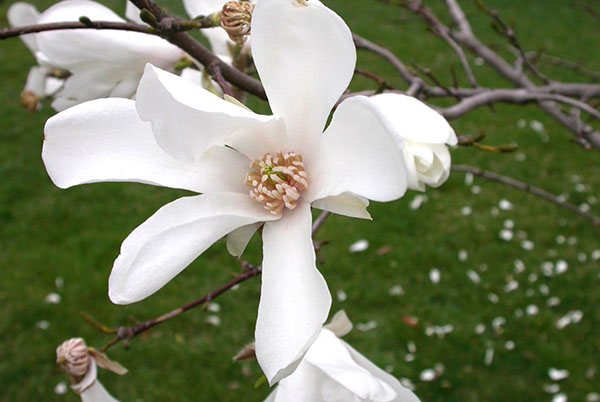

Another magnolia tree grows in Japan with white flowers and the highest degree of hardiness. This is willow magnolia, beauty not inferior to the previous species, and winter hardiness - cobus magnolia.
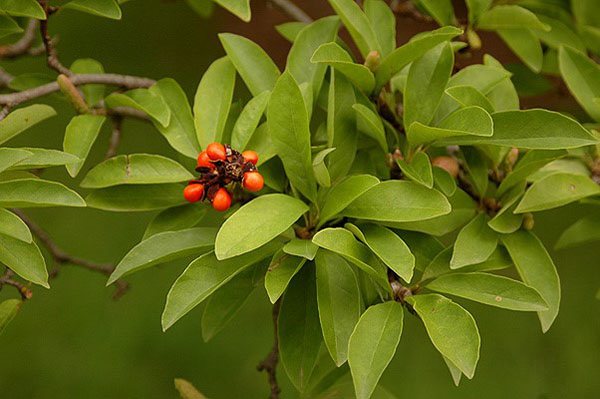

The plant owes its name to narrow elliptical leaves about 15 cm long. They appear after flowering, in which the tree is covered with spectacular flowers with a diameter of 12 centimeters. Both greens and magnolia flowers emit a sweet-spicy aroma of anise, which determined the second name of the Anise Magnolia species.
Despite the many advantages, plants are rarely found in collections. The reason is the difficulty of seed reproduction.
What magnolias can be grown in the middle lane
Of the large number of varieties of magnolia for growing in the middle lane, two of them are suitable - magnolia star (Magnolia stellata) and magnolia cobus (Magnolia kobus). Both plants are deciduous shrubs (less often a tree) with large fragrant flowers of white or pink color. Depending on the variety, they can be simple or terry.
In addition, in the middle lane, a hybrid of star magnolia and cobus magnolia has taken root well - magnolia Lebner (Magnolia × loebneri). In severe winters, this plant only freezes some buds, but this does not prevent the tree from recovering. Moreover, with age, magnolia gets used to the cold even more, and an adult plant is already able to winter without shelter.
In the gardens of the middle lane, magnolia is most often grown star-shaped such varieties as Royal star (with huge white flowers), Rosea (with pink plain flowers) and Waterlily (with white double flowers).
Magnolia features
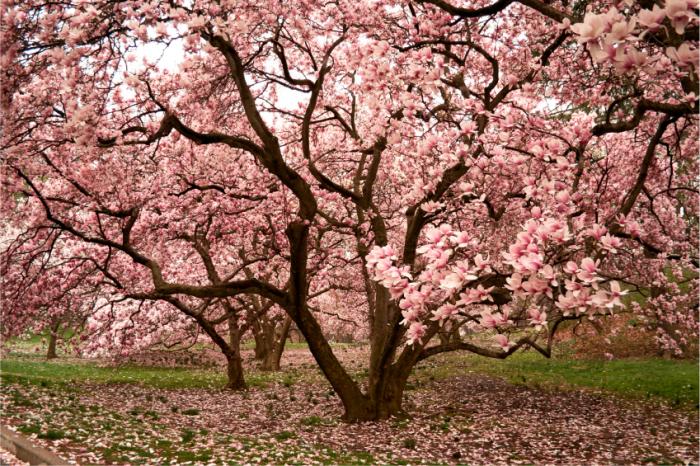

Magnolia is a deciduous shrub or tree. The bark is smooth, grayish-ash or brown, it can be scaly or furrowed. The height of such a plant can vary from 5 to 20 meters. On the surface of its stems, large scars from leaf plates are clearly distinguishable, as well as narrow ring-shaped scars from stipules. The kidneys are relatively large. Large leathery whole-edged leaf plates of greenish-emerald color have slight pubescence on the seamy surface, and, as a rule, are elliptical or obovate. Fragrant single bisexual flowers can be axillary or terminal, their diameter is about 6–35 centimeters, and color: cream, red, purple, white, pink or lilac. The flower consists of 6 to 12 waxy elongated petals, which overlap each other in a tiled pattern. Such petals are located in 1 or several rows. Magnolia usually blooms early in the spring, but there are species that bloom in the first weeks of the summer. This plant blooms so beautifully that every gardener would certainly like to decorate his garden with it.
The fruit is a cone-shaped composite leaflet, which consists of a large number of one-seeded leaflets. Black seeds are triangular in shape and have a red or pink fleshy seed. When the leaflets open, the seeds hang from the seed filaments.
Both the shrub and the magnolia tree are highly decorative plants. It looks most impressive in spring. Blooming magnolia is the most beautiful sight that every person who has seen it at least once will definitely not be able to forget. However, magnolia is a valuable plant not only because of its beauty. The fact is that in its fruits, flowers and foliage there are essential oils that have a powerful antiseptic effect, they are used for hypertension, rheumatism and various diseases of the gastrointestinal tract.
When is the best time to plant magnolia - fall or spring?
About the timing of planting magnolia, the opinions of gardeners differ. Some believe that the optimal time is spring (mid-April).Others argue that autumn planting (mid to late October) is more preferable, when young plants have already stopped growing and are dormant. Adherents of the autumn planting of magnolia argue that the survival rate of seedlings in this case is almost 100%, and during spring planting, plants often start growing ahead of time and fall under return spring frosts.
It is difficult to recommend any specific time frame. In this matter, it is best to rely on your experience and take into account the climatic conditions of your region.
Photo of magnolias in landscape design
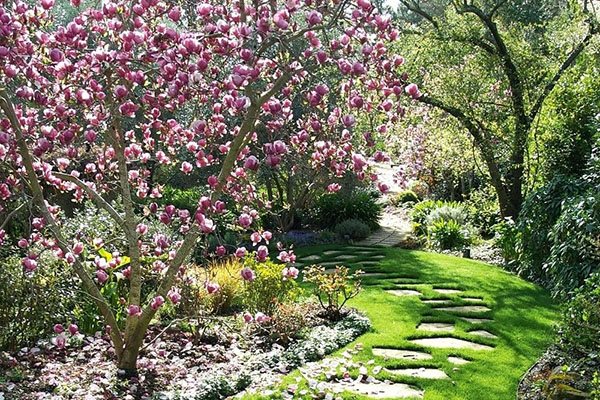

Beautifully flowering trees dominate any landscape.
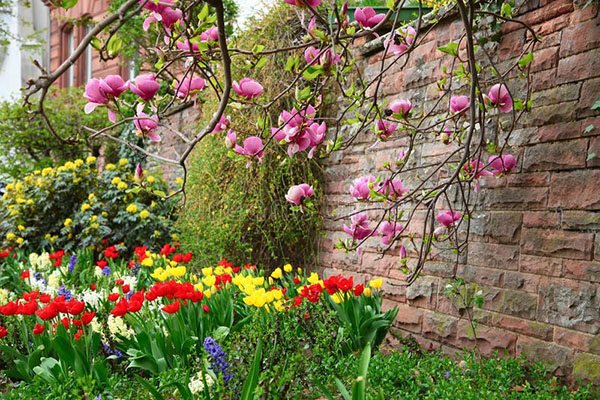

At the same time, magnolias look great against the backdrop of urban buildings and rural spaces, in parks where trees coexist with other plants, and in solitary plantings.
How to plant magnolia outdoors
It is important to choose and prepare the right place for planting magnolias. It should be sunny and sheltered from the wind. Species blooming in early spring should be protected from the morning sun. Magnolia should not be planted in southern areas: the plant will bloom too early and may lose buds during recurrent frosts.
Magnolia will love the place in partial shade, as well as on the western or eastern side of the garden plot. You can place the plant on the north side, but on condition that it will be illuminated by the sun for at least several hours a day.
Magnolia is best planted in peat soil, as the plant prefers a nutritious, slightly moist and well-drained substrate with an acidic or slightly acidic reaction. But it can also grow on acidic sandy loam or loamy soil.
For planting magnolia, a soil mixture of sod land, peat and compost in a ratio of 2: 1: 1 is good.
The planting hole should be 2-3 times the size of the seedling earthen clod. As a rule, the hole is made with a depth and width of about 1 m.A drainage must be laid at the bottom, after which the magnolia is planted in a prepared soil mixture to the same depth at which it grew before (the horse neck is not buried in any case!). the soil is slightly compacted and watered abundantly. After the water is absorbed, the trunk circle is mulched with peat or pieces of coniferous bark.
Magnolia nude (M. denudata)
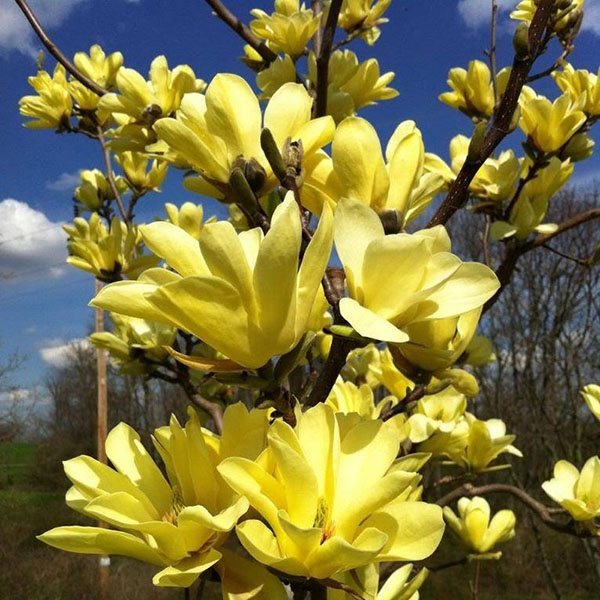

According to the monastic chronicles of the Tang era, one of the first types of magnolia used to decorate the landscape was a naked magnolia with white fragrant flowers up to 15 cm in diameter.
Outwardly, deciduous trees or 8-10 meter shrubs resemble sulange magnolia. This is not surprising as the Chinese variety is apparently one of the ancestors of the popular hybrid.
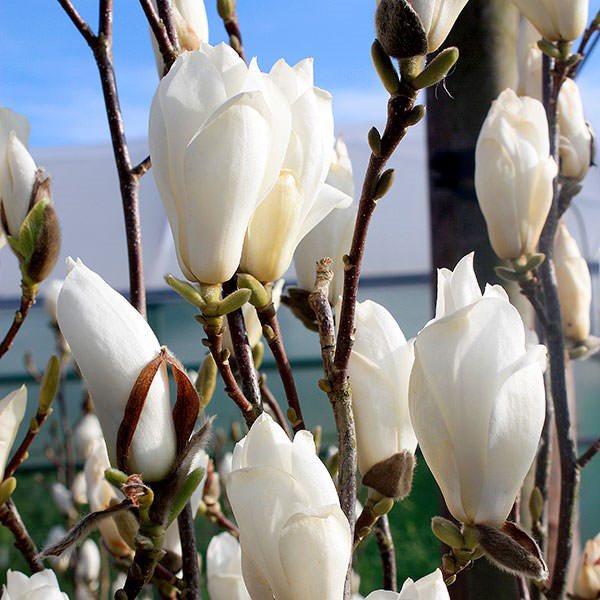

The plant is unique in flowering, which begins in early spring, when the leaf buds have not yet woken up, and the brownish shoots remain bare. At first, the bare magnolia trees are covered with large buds in silvery fluffy scales. Then they turn into snow-white fragrant flowers, which for many centuries were considered in the Celestial Empire a symbol of purity and divine purity.
There are flowering plants in collections in the Far East and in European regions from the North Caucasus to the Black Earth Region.
Magnolia care
In the middle lane, magnolias bloom in April-May - simultaneously with small-bulbous and hellebores. But for abundant flowering, the plant needs nutrients.
Top dressing begin to be carried out 2 years after planting the seedling in the ground.
In the spring, a complex mineral fertilizer should be applied under the magnolia root (the granules can simply be scattered under the plant). Florists most often use Kemiru Universal. At the beginning of summer, it is worth switching to liquid fertilizing, alternating mineral fertilizers with organic ones.
You can make your own magnolia fertilizer. To do this, dissolve 15 g of urea (carbamide), 20 g of ammonium nitrate, 1 kg of mullein in 10 liters of water.Fertilizer consumption per adult medium-sized tree is 10-15 liters.
In the second half of July - early August, for better wood ripening and increasing winter hardiness, it is advisable to feed the magnolia with phosphorus-potassium fertilizers (according to the instructions). From late August to spring, no fertilizers are applied.
If necessary increase soil acidity, you need to add sulfur to the soil in the spring. To do this, scatter about 50 g of the substance on the soil surface in the area of the trunk circle.
Magnolia demanding on soil moisture, especially at a young age. In hot weather, it is important to prevent the soil from drying out. Abundant watering and mulching will help the plant's root system develop properly.
Magnolia has the advantage of being does not need formative pruning, since this does not affect either the splendor of the crown or flowering. After the inflorescence wilting, only dried and damaged shoots are removed.
And here sanitary pruning magnolias should be done regularly. In the spring, trim off frozen branch ends to healthy tissue. Also remember to cut out any damaged, withered, and overlapping branches. Cover all sections with garden pitch.
Magnolia flower: beneficial properties and uses
After you have managed to find out how to plant an exotic beauty, it is worth studying what properties it has, as well as where it is used.
The first thing to note is that the tree is poisonous and if you inhale the scent of its flowers for too long, it can lead to headaches.
But this does not mean that the magnolia shrub is harmful, and you need to abandon its cultivation. The fact is that it has a lot of useful qualities that you can find out about now.
- Thanks to tinctures, blood pressure decreases.
- You can also get rid of bronchial asthma.
- In addition, it is an excellent antiseptic and with its help, the occurrence of caries is prevented.
The tree is also used in folk medicine, where it helps in the treatment of many ailments. Without exception, all parts of the plant are endowed with useful properties, therefore, both flowers and branches, and the bark and foliage of a tree are suitable for creating a drug.
Strengthening hair with magnolia
To make your hair stronger, you will need leaves, which will need to be chopped up. For one liter of boiling water, 3 tablespoons of foliage are used. Let them brew for a day and then you can use. After washing your hair with regular shampoo, rinse your hair with the infusion of the leaves.
In the East, charming flowers are very often used for the composition of a wedding bouquet for the bride. Snow-white delicate petals, as it were, symbolize the purity and innocence of the girl.
The tulip tree is, first of all, the creation of unforgettable beauty. She bewitches people around with her flowering. But in order to see this amazing process, you need to properly care for the plant, not forgetting about some of the nuances. Remember planting magnolias in the fall, this is the most favorable time and if your seedling begins to master the garden on autumn days, then it will certainly survive and will delight you for many years.
How to prepare a magnolia for winter
Young magnolia bushes need cover for the winter with spunbond... This is necessary not only to help the plants overwinter, but also to protect them from birds: birds are very fond of feasting on magnolia buds.
Wrapping the trunk with two layers of burlap will save the plant from frost damage. But this is done very carefully, since the magnolia has fragile branches.
Warming the roots for the winter also contributes mulching... It should be done regularly, but especially in late autumn. Dry fallen leaves, peat, humus, tree bark, coniferous branches, straw are suitable as mulch.
In young plants, when the soil freezes a little, the trunk circle is also protected with a non-woven material. In such a shelter, rodents will not be able to equip their home.
As you can see, subject to all the rules of agricultural technology and proper care, you can grow magnolia in the middle lane. Do not be afraid to experiment - and you will succeed!
Magnolia after flowering
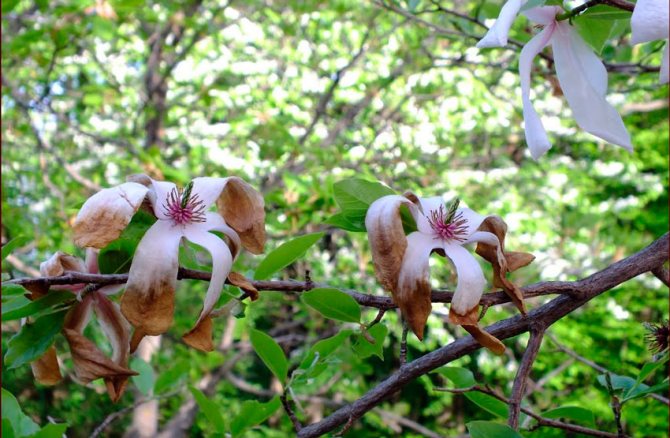

How to care after flowering
Magnolia blooms in spring or early summer. A magnolia covered with flowers is the queen of the garden trees. After the plant has faded, it will need to be pruned for sanitary purposes. To do this, it is necessary to cut off all wilted flowers, as well as branches and stems injured and damaged by frost, as well as those that grow inside the crown. Non-flowering magnolia is also very decorative, as it has beautiful leathery leaf plates.
Wintering
Preparing the plant for winter should be done in late autumn. The shelter should be good and reliable, because even if you are growing a winter-hardy magnolia, it can still freeze, especially if the winter is windy and with little snow. To exclude freezing of the plant, its trunk must be wrapped in burlap in 2 layers, while trying to prevent the delicate branches from being injured. After the first frost, the surface of the trunk circle must be mulched with a thick layer.
Magnolia: Planting, Growing and Nursing Outdoors (Based on Your Own Experience)
For a very long time I wanted to have beauty in my garden, one might say, unearthly - magnolia. I often admired it when I was in the south - majestic trees with large leathery leaves and - lotus flowers among them, emitting a delicate, enchanting aroma. It was even a little offensive that in Central Russia this miracle is not growing.
And seven years ago, in one of the catalogs of a gardening company, I suddenly saw two-year-old magnolia saplings. True, the magnolia was not offered the same - the southern one, but ... Magnolia is a magnolia. Let it be of a different kind, albeit shorter, but after all - a magnolia! And I ordered this miracle, took a chance, and everything turned out great.
All winter I was looking for any information on growing magnolias in books, magazines and newspapers of garden and flower themes and looked forward to spring, when this beauty was to be sent to me. From the parcel I took out a pot with a small sprig. Three pale dense leaves on a thin gray stem. My magnolia star - such a pet.
Magnolia pointed (M. acuminata)


Several interesting species of magnolia are native to the North American continent. In the mountainous regions of the central United States, you can see a pointed magnolia with a high crown, reddish bark and elliptical leaves up to 20 cm long.
Unlike Asian species, which bloom before foliage appears, most American plants bloom against a backdrop of greenery. Therefore, the buds and yellow-green flowers that resemble bells do not look so impressive. However, this does not prevent botanists from taking a serious interest in the hardy species that crosses well with other magnolias.
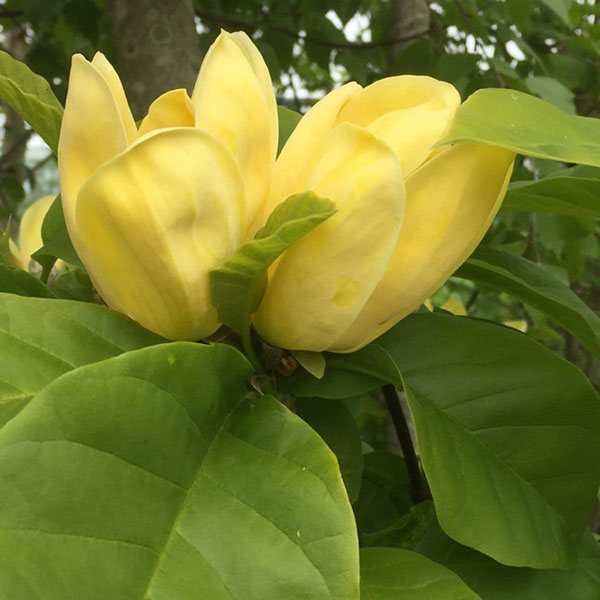

Magnolia with red fruits transfers excellent winter hardiness to its descendants from interspecific crossing. And its seedlings serve as rootstocks for more decorative, but less docile relatives. An example of successful hybridization is the Brooklyn magnolia, which is not afraid of frost and decorates the garden with purple flowers, in shape and tone reminiscent of the mother plant - lily magnolia. Russia has a successful experience of growing M. acuminata f. cordata with small flowers of a rich yellow hue.
Due to the similarity of magnolia ovaries to cucumbers in the United States, the plant is often called the cucumber tree. However, the official name Cucumber magnolia refers only to M. acuminata.
Where and how to plant magnolia?
Over the winter I determined a place for her - in front of the house, from the south-west side.The house is a good protection from the north winds. But the sun will illuminate and warm her all day. In winter, it will be warmer near the house and roots.
In early spring, as soon as the snow melted, I prepared a place for planting: I mixed the soil (black soil with sand) with compost, added a little expanded clay for drainage. So that the soil does not dry out quickly, if I do not have time to water it, I added half a packet of bentonite cat litter. Bentonite perfectly absorbs and retains moisture, contains nutritious minerals. Measles plants in drought take water, calcium, magnesium, sodium, etc.
In May, as just got my magnolia, proceeded to landing... She carefully took out a seedling so as not to disturb the young roots, planted to the place prepared for her. Spring and summer were dry that year. And I rarely watered: firstly, so as not to overmoisten too much, and secondly, the roots in the ground had enough moisture. Soon, several more small twigs appeared, the leaves were elongated, green.
Daisies, eschsholzia, purslane became the neighbors of magnolias - they covered the soil from rapid drying, covering the ground with a carpet. Magnolia does not like acidic and alkaline soils. Therefore, when choosing a suitable place for it, you need to take into account the level of acidity. In the south, magnolia grows even in partial shade. But in the Middle Lane, she needs very good lighting. Here she is better to plant on the south, south-east and south-west side, in a quiet place protected from winds and drafts. Be sure to have at least something to protect it from the north: a house, a high fence, a high hedge. It is also necessary to take into account that in the middle lane the stellate magnolia grows up to 2.5-3 m.Accordingly, the protection from cold northern winds should be higher than 3 m.
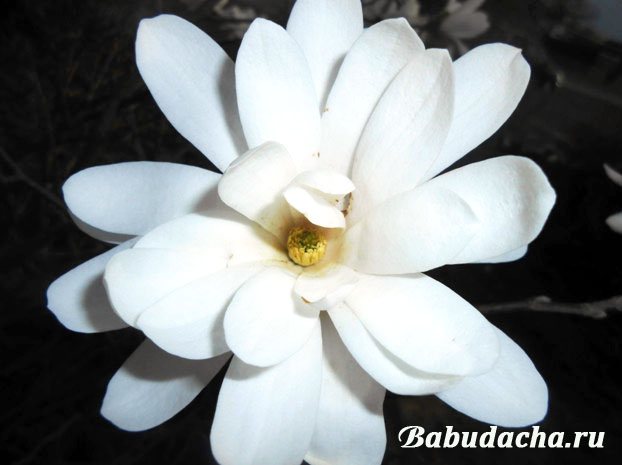

Reproduction at home
The plant reproduces in two ways: by seeds (sexual reproduction) and by cuttings, grafts and branches (vegetative or asexual reproduction). Living in a natural environment, reproduction occurs mainly with the help of seeds. Thus, several small plants grow about one large plant, forming a whole family.
It is this reproduction that allows expanding genetic diversity and obtaining more resistant species to a specific habitat, because each such new plant acquires greater resistance and ability to survive.
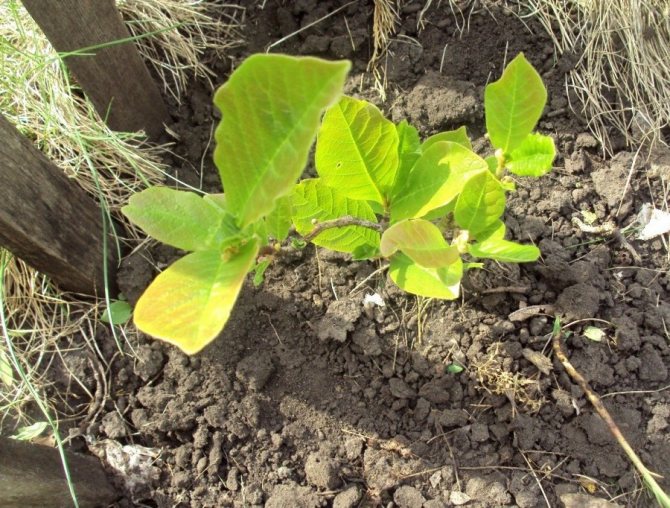

In turn, vegetative propagation only duplicates the main plant from which the shoot was taken. Most often, gardeners prefer vegetative propagation, but the method of growing magnolias using seeds is also not bypassed.
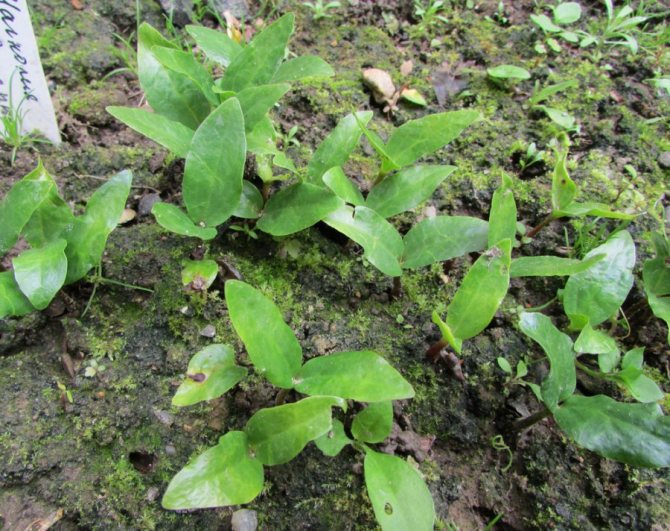

Nuances of care
- Crown formation
Star magnolia can be formed with a tree, or you can let it grow as a large shrub. I didn't torture the seedling - let it grow as it wants. And the magnolia grew into a bush (from the root it gave five main stems).
I never cut it off. And my beauty grew up in the shape of a fluffy Christmas tree, but not prickly.
Instead of pruning, which can damage a particularly young plant, I just periodically remove dried and old branches, as well as those that grow incorrectly - inside the bush or drowning out the rest. This must be done very carefully, since the branches of the magnolia are fragile, brittle. And you need to try not to damage the buds on healthy branches.
2. Magnolia in winter
In the fall, the magnolia shed some of its leaves. So that she does not freeze in the first winter, when a stable daytime temperature sets in - from 2 to 4 degrees - she covered it with a five-liter plastic bottle from under mineral water (I cut off the bottom of the bottle and removed the lid). Around the bottle I laid the grass left after weeding (I cover the roses too - they winter well). It turned out a circle about 50 cm wide and 20-25 cm high. When the daytime temperature dropped to 5-7 C, a ball of crumpled newsprint was fixed on the neck of the bottle (the air passed to the magnolia, but not so cold).
In winter I also threw snow on this mini-greenhouse, the more, the better. Magnolia spent the winter like this under the snow for two years. Then the bottle was already small for her.
Since then, when the temperature is about zero, I tie the bush with a soft wide wire, collecting it, as it were, in a bundle. In cold weather, this is no longer possible - the branches of the magnolia become brittle, you can damage the bush. Around the end of November-beginning of December, I wrap the tied bush with insulation for the walls, then I tie it with a wire again so that the shelter does not open due to strong winter winds. When it snows, I throw it to the magnolia in a circle. And in such a snowdrift with a wrapped upper part, the bush has been wintering safely for six years.
3. Spring Summer Autumn. Care
In the spring I take off the shelter. On the branches, the already swollen buds resemble pussy willow fluffs, which soon bloom. White semi-double flowers on still bare branches attract everyone's attention. A wonderful aroma keeps you near the bush, you want to breathe and breathe with this vanilla-citrus air.
The spectacle of a blooming magnolia is an extravaganza! Crocuses are already fading, fruit trees do not even think to bloom, and here - in a white fragrant cloud such beauty. When the magnolia is just starting to bloom, light green leaves begin from the smaller fluffy buds, very delicate and soft at first. By the end of spring, the leaves become very dense, leathery, similar to laurel.
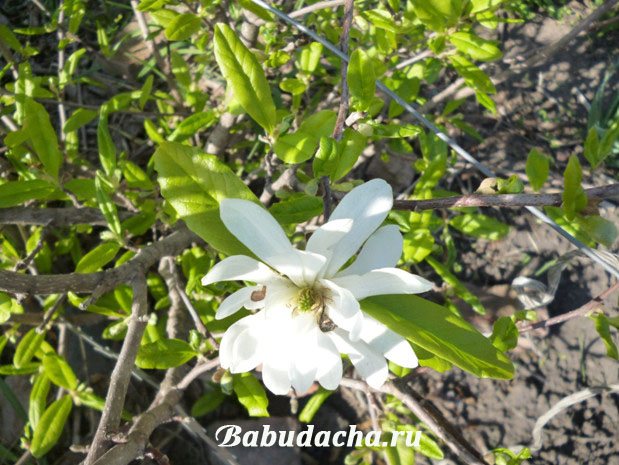

If in the south the magnolia blooms at the end of summer, then in the Middle Lane the flower buds laid in August-early September bloom in April.
4. Watering and feeding magnolia
This beauty is not very demanding in care. In principle, an adult plant in the Black Earth Region may not be covered (if the magnolia is planted in the right place). However, if you want it to bloom magnificently and for a long time, it is better to protect it from severe frosts.
But she needs watering, but only during dry periods. It is better to water it with rain or settled water in order to prevent liming of the soil and its roots, watering is especially important for a young plant. Every season I mix the topsoil with bentonite in the spring, the second time in the fall (in October). This is both feeding and maintaining moisture for the roots.
It is better to give top dressing to an already adult magnolia, from 3 years old, so as not to burn its delicate roots with fertilizers earlier.
In the spring, you can add nitrogen fertilizing (urea, for example, 250 g per 10 l of water), at the beginning of summer give organic matter (200 g of chicken manure per 10 l of water), in the fall - nitroammofosk (12-15 g per 10 l of water). In November, to strengthen the immune system, so that the magnolia overwinters successfully, I water it with zircon once a week, even spray the branches with buds. In the spring, having removed the shelter, again three or four times (depending on the state of the magnolia) I spray and water with zircon.
Large-leaved magnolia (M. macrophylla)
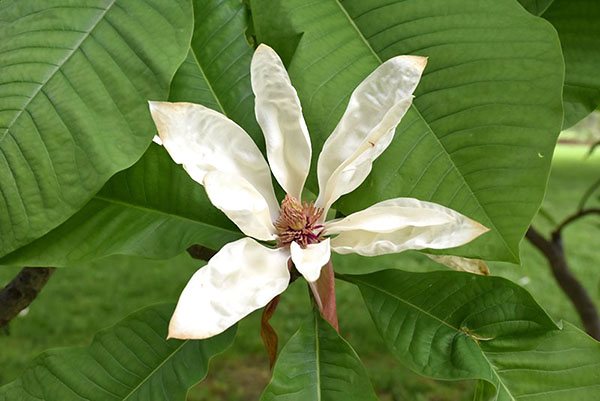

Large-leaved magnolia grows on the Atlantic coast of the United States. The deciduous perennial lives up to its name. The leaf plates on the branches of 15-18 meter-long trees reach a length of 80-100 cm. The upper part facing the sun is smooth and painted in green tones, the bluish back of the leaf is covered with a delicate, silky bristle.
In North America, the magnolia of this species is a kind of record holder, since there is no tree with larger leaves on the entire continent.
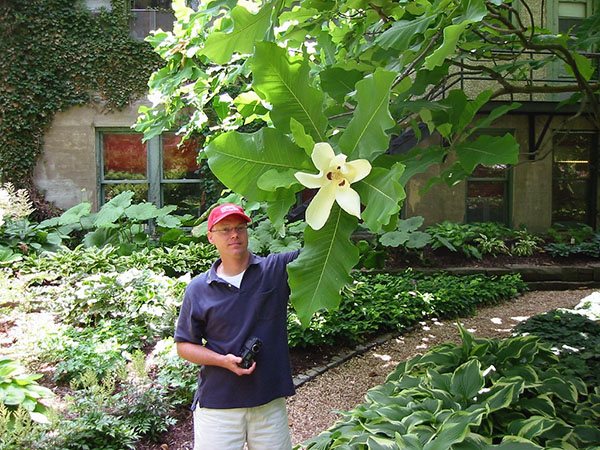

Flowering is no less impressive. The buds, which are more often formed in the upper part of the crown, open up and turn into huge 30 cm corollas of a milky white hue. On their inside, you can see a distinctive feature of the species - three purple-violet specks.
The flowering of Magnolia macrophylla lasts up to 45 days, while the tree is enveloped in a sweet-spicy, rather strong aroma.
The trees are able to withstand frosts down to -27 ° C, but they are used for landscaping only in the south of the country along with Asian species and spectacular large-flowered magnolia.
Pruning
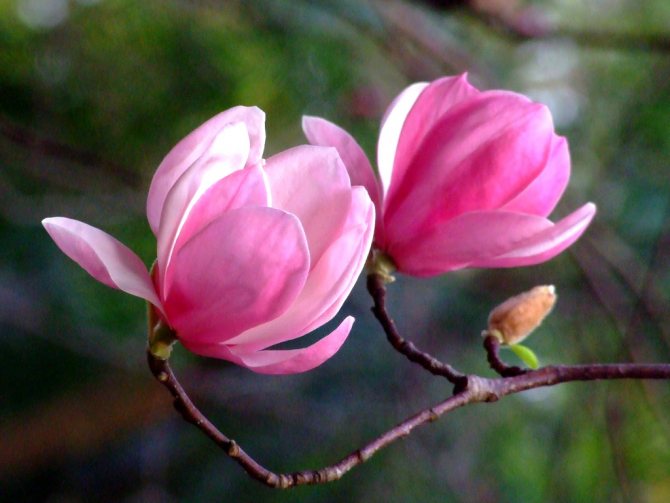

A blooming magnolia tree is quite difficult to tolerate pruning.Therefore, this procedure is carried out only in the first years and in order to improve the decorative properties. You should not get carried away with the process of crown formation, as this can negatively affect flowering. For an adult tree, only sanitary pruning is recommended, with the removal of dry, damaged and diseased branches. Such processing is carried out no more than once a year. It is permissible to thin out a crown that is too dense, but at the same time it is important to immediately process the cut sites with garden pitch in order to avoid the loss of nutrients.
Siebold


Magnolia Siebold
Magnolia Siebold is a graceful deciduous tree or shrub up to 10 meters high. The leaves are large and wide. The flowers are milky, fragrant, on a thin peduncle covered with fluff. The plant bears flower buds in June, sometimes there is a repeated single flowering in late summer. The tropical goddess bears fruit in late September or October. Magnolia fruits are multifaceted oblong, raspberry-colored. The culture is frost-resistant.
Magnolia: how to keep a plant in winter
Mature trees tolerate temperatures down to -25-30 ° C in winter. Therefore, the question of how to preserve mature magnolia in winter is no longer in front of its owner. But you need to worry about young plants. In the first 3 years, their lower part of the trunk and root system (or even completely a tree) must be insulated with a special agrotechnical cloth (lutrasil), burlap, straw or spruce branches. With age, the frost resistance of magnolias increases.
In subsequent years, the land in the near-trunk circle in the fall needs to be mulched with sawdust, pine bark, and peat.
What does a magnolia look like
Magnolias are trees or shrubs with beautiful, fragrant flowers that are milky, white or pinkish purple in color. The leaves are large, most often elliptical or obovate. Fruits are cone-shaped composite leaflets, seeds are black, wedge-ovate.
Meaning and application
Due to the beauty of leaves and flowers, as well as original fruits, magnolias are used as ornamental trees and shrubs. They decorate the alleys of the Black Sea cities, planting them in groups or singly. Magnolias are the basis of park vegetation in many resort cities of the CIS, such as Sochi, Adler and Yalta.
It is widely used in folk medicine. Magnolia leaves are most often used as medicinal raw materials. - they contain essential oils, flavonoids and alkaloids, minerals. Magnolia flowers, roots and fruits are also rich in nutrients.
Magnolia essential oil is used in cosmetology, perfumery and aromatherapy. It is obtained from the flowers and leaves of the tree and is used in the manufacture of tonic lotions and creams. The fragrant smell of the oil soothes the nervous system and the body.


The plant is an excellent antiseptic. It protects the oral cavity from inflammation and microbes that cause tooth decay. The medicinal tincture was used in antiquity for prophylactic purposes to normalize blood pressure and asthma. It also relieves fever.
Tincture recipe
: on alcohol, seeds, fruits and bark of a bush insist on for 20 days. The resulting extract is filtered, diluted with water and taken 10–20 drops 4 times a day. In combination with other medicinal herbs, this tincture is used for external use in rheumatism.
Growing magnolias in a garden from seeds
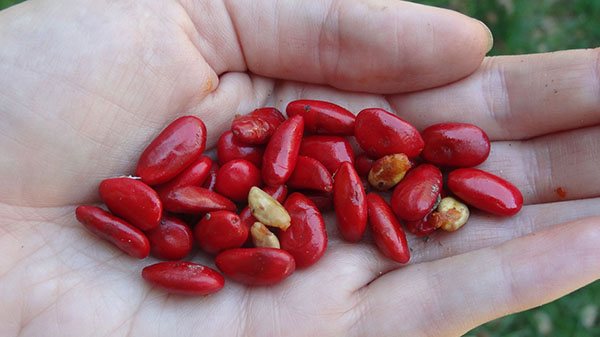

To date, it is not a problem to acquire the seed of this culture. For cultivation in the suburbs, Siebold's magnolia is most often bought. As a rule, the grains are covered with a protective shell (sarcotesta). Beneath it there will be another layer in the form of a white oily substance. It protects seeds from early germination. All these shells must be removed before planting. Rinse the seeds themselves well with clean running water. The next step is to subject it to cold hardening (stratification).
Some gardeners sow frost-hardy magnolia seeds in the fall directly into open soil, covering them with leaves.
Wrap the grains in slightly moistened moss and leave them in the refrigerator on the bottom shelf for about 3-5 months. The most suitable temperature is 0 °. If it is lower, seeds and seedlings may die. Check the material once a week. As soon as the grains germinate, plant them in containers. Take a sufficiently deep pot (about 40 cm), fill it with fertile soil with peat.
Growing magnolias in the garden requires soil monitoring. Souring of the soil is unacceptable, it must be well-drained to allow air to pass to the roots. Lay out the bottom of the pot with a 10 cm layer of expanded clay drainage. Soak germinated seeds in a stimulant solution (as indicated in the instructions). Bury each grain about 2 cm in moist soil. Place the container in a warm place with plenty of bright, diffused light. If the air is very dry, take care of the greenhouse. After the emergence of seedlings, the conditions of detention remain the same. When two pairs of leaves are formed, water with a weakly concentrated solution of fertilizer for seedlings.
Planting magnolias is best done in the fall, when young seedlings stop growing. Depending on the region, sometime in early or mid-October. That is, when there is no frost yet, but it is no longer hot outside.
Willow


Willow magnolia
Willow magnolia is a graceful deciduous tree or large shrub up to 10 m high, with a conical crown that has several tiers. The bark of the trunk of the willow-leaved magnolia is smooth, smoky in color. Young shoots of representatives of the species are lead-olive, delicate and silky. Adult shoots are smoky brown, greenish. The leaves are long and narrow, pointed, oval in shape. The leaf plate is light olive on top, gray-gray below, covered with tiny hairs along the veins.
The magnolia flowers are creamy, with a strong aniseed scent, and are bell-shaped in shape. The flowering stage begins before the leaves open, in the first half or mid-April. Re-blooming is possible in August or September. The fruit is a composite leaflet, shaped like a slightly curved cylinder.
Interestingly, in the process of growth, from the illuminated side, the fruits acquire a pinkish tint. If you grind the vegetative parts of the plant, the air will be filled with aniseed scent.
Cutting and propagation by layering
The use of vegetative propagation methods of the magnolia tree promotes faster flowering than with seed propagation. These methods are good for the condition of the tree, especially in the early years of growth.
Reproduction of magnolia by air layers is carried out in late spring or early summer. To do this, a circular cut of the bark is made on the branch without touching the wood. Its width should be about 3 centimeters. The cut site is treated with a growth stimulant (for example, "Heteroauxin"), covered with moss and wrapped in a film. The branch is tied to adjacent branches to protect it from damage caused by strong winds. After two to three months, roots are formed on the cut, ready for transplantation.
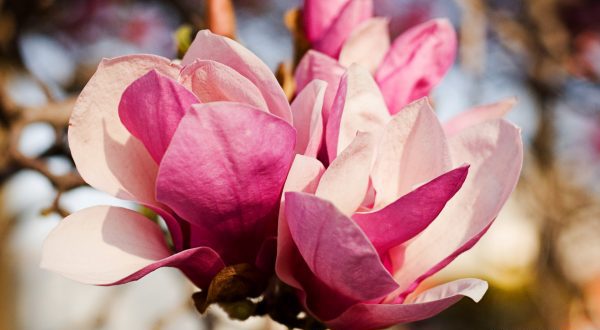

Cuttings are carried out at the end of July. Cuttings are cut from the branches of a young tree, leaving at least two leaves. The lower part of the cut is treated with a growth stimulant, after which the cutting is planted in the sand. It is better to germinate the cuttings in greenhouse conditions, at a temperature of at least + 22 ° C and moderate humidity. Rooting occurs 1.5-2 months after planting. In winter, the cuttings are transferred to a warm room, and the next spring they are transplanted into open ground.
Top dressing and other secrets
You can achieve lush flowering from a plant if you follow certain rules:
- Fertilizers are needed for stable growth and beautiful flowering. The first feeding of magnolias is carried out in the spring.In order for the plant to bloom beautifully, it is better to add mineral compositions with a high nitrogen content to the soil (excellent growth stimulation). When buds are tied and during flowering, it is better to use special complexes designed for flowering plants. Dosages are calculated strictly according to the instructions. July is the time of the last feeding. From the end of August, magnolias gradually enter a dormant period and prepare for wintering. Any stimulation of growth at this time is contraindicated.
- The bottom of the trunk and roots must be covered for the winter. To do this, use a special cloth, straw or spruce branches.
- Care must be taken with transplants. The superficial root system is very easy to damage. Therefore, if you can see that the tree is good in the selected area, you do not need to transfer it anywhere.
- The crop is believed to be disease and pest resistant. But for prevention, it is still worth periodically treating with special biological products.
- Planting and caring for magnolia outdoors includes pruning. But this should be done only when necessary: for example, if there are branches crossed inside the crown. They need to be cut. This procedure will improve growth and decorativeness. Remove dry branches and frozen buds after flowering. All sections must be processed with garden pitch. Cut magnolias shrubs to give them a compact and beautiful shape.
Feel free to experiment. Create favorable conditions in your garden and you will definitely make friends with this exotic beauty.
Growing magnolia in the middle lane - video
Soil requirements
Magnolia requires some care. If you know the peculiarities of planting and the rules of care, then growing a tree with flowers of extraordinary beauty will not give the gardener any trouble.
Tomato tree
A favorable soil for magnolia is considered to be moderately moist, drained, fertile, with a low level of acidity. The plant will not grow in saline or limestone soil.
Soil composition for planting:
- Peat mixture;
- Sod land (deciduous can be used);
- Sand.
The successful growth of a flowering tree depends on the soil.
It is better to purchase seedlings for planting in trusted stores. A plant with a closed root system quickly takes root in a new place during spring or autumn planting. The seedling should be from 1 m tall with several blossoming flowers. This is how you can determine that this variety is suitable for the local climate.
Magnolia care and cultivation: transplant
Magnolia prefers to grow all its life in the place where it was originally planted, but only sometimes there are situations when it needs to be urgently transplanted. To do this, you need to find a site that suits her by all criteria.
- Before starting to dig up the bush, be sure to thoroughly water the soil around it.
- It should also be borne in mind that the earthen lump that remains on the root system depends on how well the planting specimen will take root in a new place.
- The plant should be moved with oilcloth or plywood.
- You need to transplant, observing all the rules, as well as when planting.
- The first thing to do is to dig a hole, lay drainage, sand, do not forget about fertile land, and only then you need to install a tree and fill the hole with earth.
- Tamp the soil a little, but do not use force so as not to damage the root system.
Plant pruning
Magnolia is a tree or shrub, if you decide to plant something, it is worth remembering that it is unnecessary to cut branches to form a crown. Also remember that pruning is not done in the spring, as sap will start to come out of the cuts at this time of the year, which can lead to the death of the tree.
After waiting for the magnolia to bloom, carry out a sanitary pruning. Frozen branches, wilted flowers, dry shoots are removed from the shrub. Those stems that are frozen must be removed to a healthy area.Do not forget to process the cuts using a garden pitch.
How does it endure wintering
Magnolia cultivation in central Russia is carried out in almost the same way as in other regions. Be sure to cover the bush, even if it is hardy. Spring frosts kill the buds, so flowering will not come at all in the future.
Burlap is best for shelter. It is necessary to wrap it up in several layers, without injuring the branches. The trunk circle is also wrapped in mulch, only this should be done a little later, when the ground is slightly frozen. In the event that you rush to do this a little earlier, then there is a risk that mice will start in it.
Now that you know how to cover a magnolia for the winter, you can be sure that no frost will be terrible for it, provided that the rules of wintering are observed.
Parasites and diseases
For many years, it was believed that these representatives of the magnolia family were not disturbed by pests and ailments, but there are still problems that can be encountered when growing a shrub.
- If yellow spots appeared on the leaves, and their veins remained green, then this means that the plant was attacked by chlorosis. This is an indicator that the soil contains a lot of lime, in which the roots cannot grow, which leads to their death. Adding sour peat or coniferous soil to the soil will correct the situation. Special ready-made products will also help regulate acidity.
- An excess of nutrients is also harmful, as it will slow down the development and growth of the shrub. You can find out about such a problem by the drying edges of the leaves in the last days of July. To remedy the situation, you need to stop feeding and start watering the bush a little more.
If we talk about parasites, then the harm is caused by rose thrips, mealybugs and peach aphids. With the onset of drought, a spider mite or a transparent mite can attack a tree. They suck the juices out of it, and this is destructive for the shrub, because the foliage begins to crumble ahead of time. In addition, this can lead to the fact that the tulip tree will not please you with its flowering next year. Actellic solution or another similar agent will help save the situation.
With the onset of cold weather, rodents can attack, which feed on the roots and root collar. Finding out about such a problem is not easy, because for this you need to remove the top layer of soil. In order to get rid of pests, use 1% Fundazole solution.
In order to avoid the problem in the future, you need to cover the trunk circle only after the soil is freezing.
Let's dispel the misconception: "magnolias do not grow in Russia"
Magnolia can be grown in central Russia. She will bloom later than her sisters growing in warm regions. For example, magnolia Kobus, one of the most unpretentious, blooms its first flowers 11 years after planting.
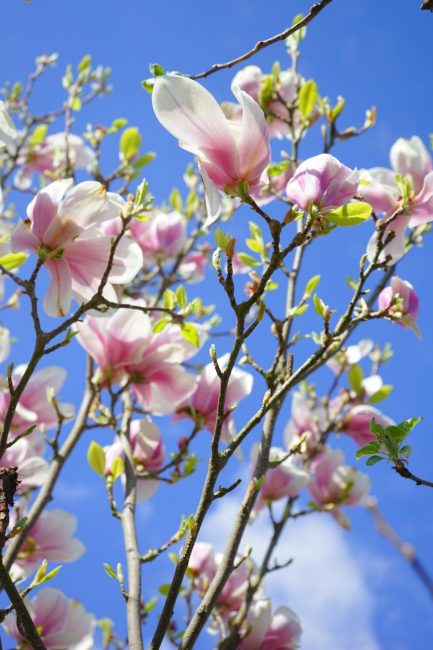

In the Moscow region, varieties of star magnolia grow well:
- Rosea
- Royal Star
As well as varieties related to the Lebner species:
- Leonard Messel
- Merrill
Hybrid varieties can be grown:
- Pinky
- Susan
For a tree to flourish, you need to consider its flowering period. Better to choose those varieties that bloom in the summer. Their seeds will not have time to ripen, but they will certainly give you flowers.
Magnolia is beautiful during flowering, and beautiful after the flowers wither due to the decorative foliage. As you can see from the article, caring for her is not so difficult, but she will pay off all the efforts spent with her charming colors.
See also: Anemones: 25 species, features of reproduction and care, planting in open ground, forcing in winter, a description of the medicinal properties of the plant (50+ Photos & Videos) + Reviews
When can you transplant magnolia to another place
The culture does not tolerate transplantation, takes root for a long time, gets sick.
It is better to carry out the procedure in the spring, when the temperature rises above 15 ° C, and the risk of recurrent frosts is minimal. Experienced gardeners recommend removing swollen inflorescences so that the plant does not waste energy on them. No pruning is done this year.
If it is necessary to transfer the decorative tree to another place, the site is chosen so as not to disturb the magnolia anymore. She may not withstand repeated intervention in growth.
To transplant magnolia:
- The shrub is watered abundantly a day before digging up.
- A planting hole is prepared: a wide depression is dug, which exceeds the earthen lump of the plant by 2 - 3 times, the bottom is covered with a drainage layer, sprinkled with sand, fertile soil mixture. Slightly moisturize, bring in a handful of organic matter.
- Dig up the magnolia, trying to preserve as much soil as possible on the roots. This makes the plant easier to adapt.
- Carefully transfer the tree to a new place, set it in the center of the prepared hole, sprinkle it with a sandy-peat substrate. The root collar must remain above the soil surface.
- The plant is poured abundantly with water, the top of the trunk circle is sprinkled with mulch.
If the transplant of magnolia in the open field was carried out in the fall, the tree and the root space are insulated for the winter.
Blooming, as well as weakened, diseased, damaged shrubs do not tolerate.
Large-flowered


Magnolia large-flowered
Magnolia large-flowered is an evergreen tree up to 30 meters high. Magnolia large-flowered has a wide crown, shaped like a pyramid. Smoky or chestnut bark. The flowers of the magnolia tree are single, growing on the tops of the shoots, voluminous, white-creamy, with an intense intoxicating scent. The flowering time lasts from May to September. The tropical culture bears fruit in October-November. The charming enchantress retains its vitality when the temperature drops to -15 degrees for a short time.
Lily


Magnolia Lily
Magnolia Lily Nigra or orchid tree is a shrub or tree up to 6 m high, with rather branched, voluminous foliage. The bark of the tree trunk is smooth, light smoky shade. Young shoots of the culture are initially olive in color, adult specimens have crimson-brown branches. The leaves of the plant are large, oval, narrowed at the base, dark olive above, light green below.
The flower buds are covered with lemon-silvery hairs. The flowers are narrow, shaped like cups, scarlet outside, milky inside, with a delicate, subtle aroma. The flowering time begins in late spring, along with the appearance of the leaves. Re-flowering is possible between July and September.
The fruit is a cylindrical multifoliate, crimson in color, with black seeds, ripens at the end of October - November.
Susan
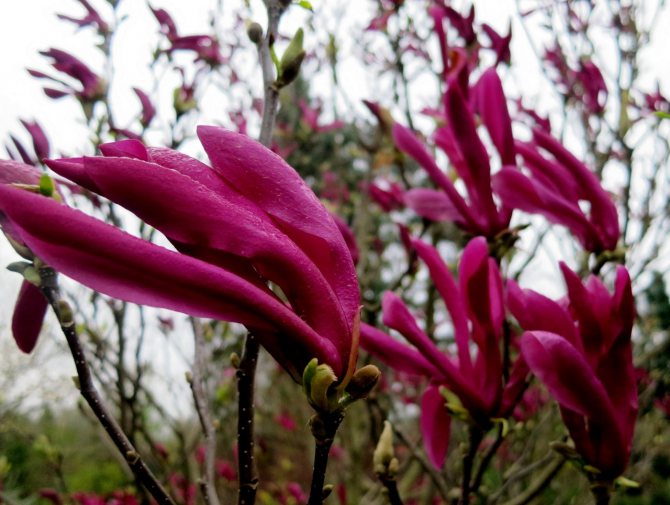

Magnolia Susan
Susan's magnolia is a popular hybrid of lily and star magnolia. It is a dense shrub up to 4 m in height, at first resembling a cone, and the older it becomes, acquiring a rounded shape. The leaves are large, dark olive. The flowers are voluminous, up to 1 cm in diameter, dark scarlet at the base, lighter at the ends. The representatives of the variety do not smell strong, but pleasant. The flowering period is long and exuberant.
The plant prefers sunny locations, no strong winds, and slightly acidic, fertile soils. In winter, specimens of the variety need shelter only in the first couple of years after planting.
Magnolia Susan is a variety, as if specially created for small, cozy gardens.
Lebner


Magnolia Lebner
Magnolia Lebner "Leonard" is a deciduous tree up to 9 m high, a hardy hybrid of Kobus and Star magnolias with a rounded crown and wonderful aroma. Leaves are oval in shape, their arrangement is alternate. The flowering time of the culture begins in mid-spring. The volumetric buds of the plant, up to 14 cm in diameter, resemble stars in shape, white or mother-of-pearl.The outer petals of the flower are distinguished by blue-scarlet or mauve stripes, inside the petals are white.
Representatives of the species prefer acidic, fertile, moist and drained soils. The place for the plant is chosen in the open sun or in a light shade. A favorable time for planting deciduous magnolia is early spring.
Magnolia Legend
The Japanese have a beautiful, sad legend associated with Magnolia. A young girl named Keiko made delicate flowers from paper for sale, but there was no profit from this activity. Once Keiko heard from a parrot whom she fed out of pity, she heard advice: you need to sprinkle paper flowers with a drop of your own blood and then they will come to life. But there is a prerequisite: a drop of blood should not be the last.
Keiko did everything as the parrot advised, and within a short time she became rich. But the man she fell in love with turned out to be greedy. He began to make the girl work all day and night - so he wanted more wealth. But one day the moment came when Keiko had to sprinkle the last drop of blood on the paper flower. By doing this, she died. The flower revived from this drop of blood began to be called Magnolia. Since that time, this flower has become a symbol of the generosity and nobility of the soul.
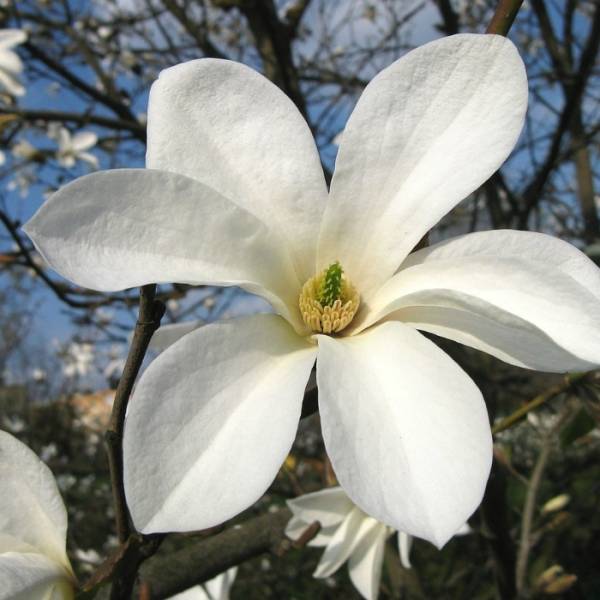

Magnolia Cobus
Magnolia photo gallery
Virginia


Sweet bay
Magnolia virginiana is a deciduous or semi-evergreen tall shrub, reaching 20 m in height. The trunk of the species is straight, the branches are bare, the buds are covered with tiny villi. Magnolia virginiana has oval, semi-evergreen leaves, with a pointed apex and a wide base, up to 12 cm long. Above, the leaf plate is dark olive, smooth, polished. Below the leaves are smoky-turquoise, delicate, velvety, pubescent along the midrib. Petioles are small, no more than 2 cm long, smooth, not pubescent.
The flowering period of representatives of the variety begins in April; blooms until July, not abundantly, but steadily. Flowers up to 7 cm in diameter, milky white, fragrant, about 9 - 12 petals.
Many culture fans believe that the flowers of Virginia magnolia have an inimitable, delightful aroma.
The fruits of the plant are dark crimson in color, up to 5 cm long, resemble an ellipse or cone in shape. The seeds are covered with a dense purple coat.
Historical reference
Magnolia is a very ancient plant, dating back to the era of the dinosaurs. This is evidenced by the petrified Magnolia flower, which was found by archaeologists. They found that this flower is at least 95 million years old.
The plant was able to survive in all cataclysms, due to the fact that it easily and quickly adapts to changing climatic conditions. In ancient times, due to the absence of bees, flowering plants were pollinated by beetles, which have retained this ability to this day.
Threefold


Umbrella tree
Magnolia three-petal is a deciduous tree up to 12 m high, with a crown that looks like an impressive umbrella. The bark of the trees is light smoky, even. Shoots are dense, crimson-lead or brown-olive, with pronounced leaf scars, buds are brown-green. The leaves are large, oblong, with a pointed apex. Above, the leaf plate is light olive, even, the leaves are greenish-gray underneath, with convex veins, covered with short hairs.
Magnolia three-petal has large flowers up to 25 cm in diameter, creamy, shaped like oblong cups. Due to this structure of flowers, beetles that pollinate them freely penetrate the buds. The fruits of the culture are multileafs of an oblong shape, wine shade, containing resinous, flat seeds. The flowering period begins after the leaves open.
Soulange
Magnolia Soulange
Magnolia Soulange is a hybrid of the naked magnolia and the lily-flowered magnolia. Magnolia Sulange is a deciduous tree or shrub up to 8 meters high.The leaves are large, light olive. The dazzling culture delights its fans with lush flowering in mid-spring. The fruits of the plant appear closer to autumn.
Magnolia of this type is able to withstand frosts down to -22 degrees. If you provide for the development of a culture sunny, protected from cold winds, it will abundantly and quite early reward its fans with luxurious buds. The plant is able to withstand the influence of unfavorable climatic conditions and is actively developing on various soils, giving preference to fertile, porous soil.
Representatives of the species constantly need sunlight, so they feel bad even in partial shade.
As for late frosts, they can harm the flowers, but the plant is able to recover rapidly.
Widely known exotic forms and varieties:
- f. Lennei - fragrant flowers, scarlet, with a pearlescent hue on the outside, milky inside;
- f. rubra - bright, crimson pink flowers;
- f. Alexandrina - mother-of-pearl flowers, dark scarlet outside;
- f. Niemetzii is a plant with a cone-shaped crown and varied flower colors, mainly white and strawberry shades.
Description and characteristics
The plant has been known since ancient times. There are many beliefs and legends about him. He is considered the ancestor of flowering trees and bushes.
Magnolia tree
The low bole of magnolia is appreciated not only for its magnificent appearance, but also for the useful essential oils that are contained in the leaves, flowers, and fruits. They are used in perfumery and traditional medicine. Magnolia oils help in the fight against hypertension, joint problems, and restore the functioning of the digestive system.
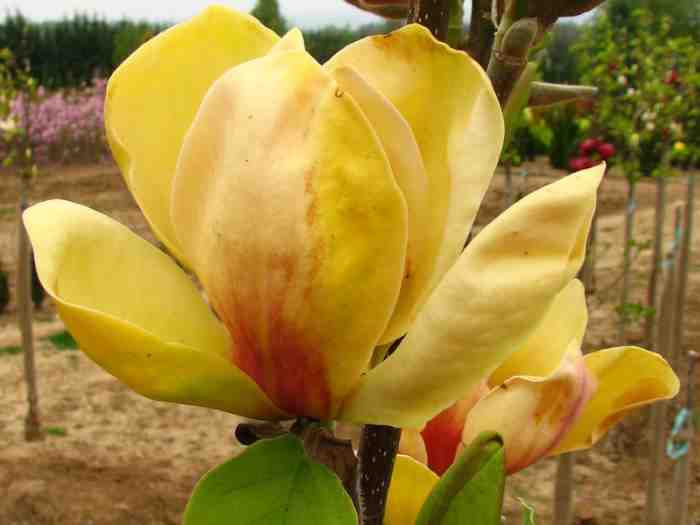

Magnolia varieties
There are many varieties of magnolia to choose from. More than 80 species of plants are grown, which differ in size, appearance of flowers (the color can be purple, pink, white, cream, yellow), climatic requirements.
Magnolia tree - botanical description
What is Magnolia? It is a flowering plant of the Magnoliaceae family that grows in tropical and subtropical climatic zones. Under natural conditions, it grows in North America, East Asia, as well as on the southernmost island of the Kuril Islands - Kunashir.
Magnolia is considered one of the most ancient plants. Scientists claim that it appeared in the Cretaceous period, which began 145 million years ago. In those days there were no bees yet, so the flowers are still adapted for pollination with the help of beetles. On the territory of Russia, five species of ancient magnolia were found - on Sakhalin, in the Urals, in the Cretaceous sediments of the Ob River, in the Volga and Don basins.
Despite its antiquity, the plant was "discovered" in the seventeenth century by the French monk and great scientist Charles Plumier. He was seriously engaged in physics and mathematics, was an excellent draftsman, artist and turner, studied botany. Participated in several expeditions to explore the Antilles, South and Central America. He brought back many new plants from the South American expedition, including magnolia and begonia.
The magnolia got its name in honor of the French botanist Pierre Magnon, in French his name is spelled Pierre Magnol. In Russia, the plant was called "Magnolia" for a very long time, but then it was transformed into "magnolia".
In ancient China, magnolia grew only in the gardens of the emperor, and exquisite dishes for the imperial family were prepared from its leaves and buds.
What does a magnolia look like? This is a shrub or small tree. May be deciduous or have evergreen leaves. The trunk and branches are light gray or brownish, smooth or covered with scales and grooves.
Photo: https://enn.imadeself.com/photos/magnolia-trees-springtime-blossoms-556718/
The leaves are large, hard and leathery, bright green, oval or ovoid. The magnolia flower is always very large and fragrant. May have six, nine or twelve petals.The color is usually white-pink, cream, white or purple. But there are many varieties and hybrids of a different color.
The elongated receptacle contains a large number of stamens and pistils adapted for beetle pollination. In this case, pollination occurs directly in the buds, before the petals open - beetles can easily penetrate the flower before it opens.
The fruit is a cone-shaped polysperm. Seeds are black, triangular.
Depending on the species, the magnolia tree can reach an average of five to seven meters in height, but there are also real twenty-meter giants. The crown of trees is pyramidal or spherical.
Magnolia flowers bloom in early or mid-spring, when even the leaves have not "hatched" on the tree. It looks very spectacular. Spring-flowering magnolias, under favorable conditions, can please you with re-flowering in early July, though not so abundant.
Some magnolia species live for over a hundred years.
Necessary care
The watering regime is important. Magnolia is especially undemanding to care for. But in order to grow a healthy plant that will delight the eye with its flowering, it is recommended to follow some rules. Given the origin of the plant, in order to grow magnolia in the Moscow region, it is necessary to monitor the moisture content of the ground cover (especially in the first years of growth).
The soil should always be moderately moist; in the heat, drying of the soil is unacceptable. Not only watering will help maintain moisture, but also covering the root space with foliage or bark of other trees - mulching. This procedure warms the roots, enriches the soil with useful components, and minimizes drying out.
The crucial moment is shelter for the winter. Magnolia is acceptable for the regions of the Moscow region (star, kobus and other hybrids), frost-resistant, but shelter will not interfere with it. Even the smallest frost can cause trouble for plants. To prevent frost damage, the barrel is wrapped in a thick cloth folded in two.
Mr. Summer resident informs: the use of magnolia
Despite the fact that magnolia contains a number of beneficial substances, it is worth knowing that it is poisonous. The infusion from the extract of the plant normalizes blood pressure, promotes recovery in bronchial asthma, and magnolia is also used as an antiseptic. Shrub extract is used by hypertensive patients. For manufacturing, you will need to mix crushed seeds (2 teaspoons) with 0.2 liters of 70% alcohol and insist for 2 weeks. Should be consumed daily before meals, 25 drops.
If you steam 3 tbsp of crushed leaves in 1 liter of boiling water. spoons and keep the resulting mixture for 24 hours, you get a rinse that helps to strengthen.
Diseases and pests
The shrub is rarely sick and is affected by insects. One of the problems that you have to face is yellowing of the foliage. Most likely, there is not enough iron in the soil. If yellow spots appear on the leaves, this indicates that the soil is oversaturated with lime.
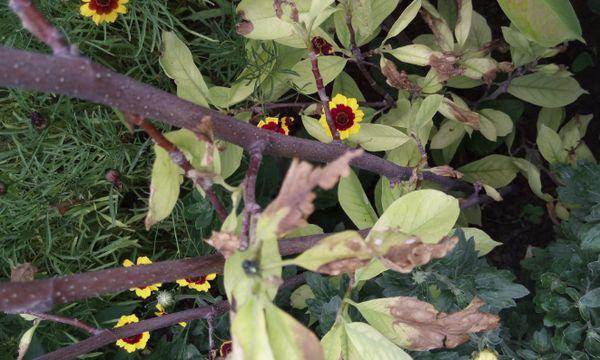

A spider mite may appear among insects on a tree. You can get rid of it with chemicals. Another problem is damage to the bark by rodents. In winter, traps can be placed next to the tree. Wrap the lower part of the trunk in two layers of burlap. Wounds from mice are treated with "Fundazol".
Genie
Camellia Genie
Genie is a hybrid of Sulange's magnolias and Nigra Liliaceae. Deciduous compact shrub up to 3 meters high, with an exquisite columnar crown shape. Elastic young shoots of olive color acquire a chestnut shade over time. Leaves are tobacco-green, oval.
Bulky, goblet flowers of a dark wine color, resemble tulips or lotus flowers in shape. Abundant flowering of representatives of the hybrid lasts all spring. Blooms again in late summer.
Description of magnolia
Magnolias include both trees and shrubs with ash-gray or brownish bark on the trunk and shoots marked with stipules.
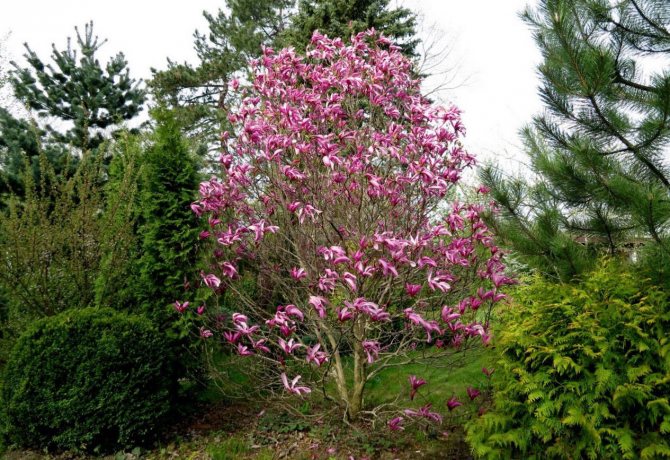

The leaf buds are spindle-shaped or narrow-cone-shaped and are dressed in two or one scales.
The foliage is large, oval, with distinct veins and solid edges.
The flowers are very picturesque, large and fragrant, they are crystal white, cream or purple hue, single.
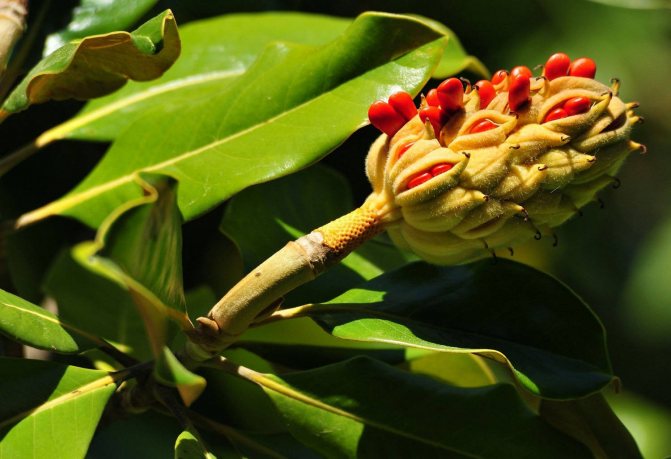

Corollas 6-9-12-lobed, with numerous pistils and stamens. They are pollinated by beetles even before the buds open.
Fruits are pineal leaflets with wedge-shaped triangular black seeds in fleshy pinkish or scarlet seedlings.
Soil and watering
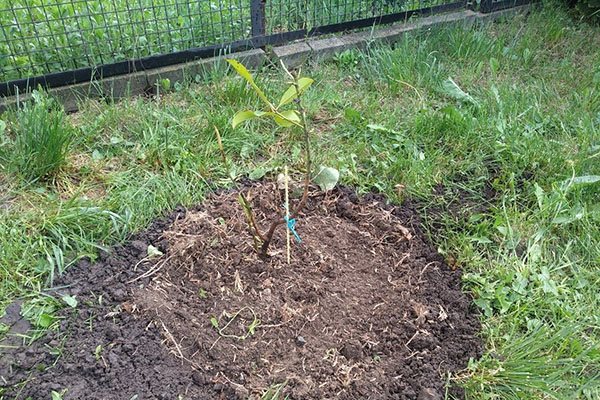

Magnolia soil should be light, slightly acidic, fertile. Also, a prerequisite for the ground is that it must pass air well. In addition, moisture in the area should not stagnate. Heavy, long-drying soil, not the best option for growing magnolias in the garden. The pit should be about three times the size of the root system in volume. Pour rubble and broken branches to the bottom as drainage. Lay out fertile soil on top (you can mix it with rotted manure and small coniferous bark).
Planting and caring for magnolia in the suburbs is no different from other regions. The main thing is to protect the roots.
Therefore, the top layer of the earth is not recommended to be strongly compacted. Be sure to mulch with coniferous bark. This will make it easier to maintain the necessary moisture and acidity of the soil. If new leaves and shoots appear, then everything is done correctly, and the plant has taken root.
Water the magnolia regularly with warm, soft water during hot weather. Avoid drying out or waterlogging the ground.
Magnolia species
There are many species, of which, by crossing one with another, even more varieties of unusual appearance and colors have appeared. Consider the main "basic" and popular among fans of exotic gardening hybrid varieties.
- Magnolia star
Correct planting and caring for the Magnolia stellata flower. After this variety begins to bloom, the entire surrounding area is filled with an unforgettable aroma. In March, the first flowers begin to bloom, after which leaves saturated with emerald green appear. Closer to autumn, they become brownish - bronze. Stellata stands out for its extra decorative characteristics due to the unusual coloration of the autumn foliage.
- Siebold
This the species is considered the most frost-resistant, after all, he is able to withstand frosts, reaching 36 degrees. The height of this shrub reaches only 4 meters, and its branches are covered with elongated leaves, among which you can see snow-white flowers. Flowering begins after leaves appear on the branches. Magnolia Siebold is grown throughout Russia, and in special large tubs, which can always be brought in if necessary, are cultivated even in the Urals and Siberia.
- Magnolia Cobus
Proper planting and grooming brings stunning results to an ornamental variety. It begins to bloom in mid-spring, releasing fragrant white unforgettable flowers. Magnolia evergreen with the onset of summer paints its foliage in a rich green color, and as soon as autumn comes, it turns yellow-brown.
- Lily Magnolia liliiflora
This variety originates in China and is bred throughout Europe.
Considered a two-tone variety... The outer side of the petals is crimson red, while the inner side is snow-white or white-pink.
The flashing bloom begins in early spring and lasts for several wonderful weeks, filled with an airy scent spread by the buds.
- Black Magnolia Nigra
Refers to the lily-colored species. The flowers on the outside are painted with a ruby color of the stone, but the inside of them is white lilac. Due to this color combination she looks almost black... You can see these unusual beautiful flowers in the 30th days of April or in the early days of May.
- Magnolia Susan planting and care
A hybrid of the star-shaped and lily-colored varieties. Susan is the most popular species among exotic lovers.
Large 15 cm lily-shaped inflorescences at the base are richly pink-crimson, and at the tips are lighter, as if glowing.
During the long and lush bloom, which begins at the end of May, less often in June, you can enjoy a pleasant, unobtrusive aroma.
- Soulange tulip magnolia
Planting and care is similar. The shape of the flowers of this variety can be both goblet and tulip-shaped. The tulip variety begins to bloom before the first leaves appear on it. After the fragrant flowering is completed and the last petal falls from the plant, decorative dark green obovate leaves continue to decorate it.
- Ash's magnolia
Magnolia ashei. The leaves, which are 70 cm long and 30 cm wide, are colored green. Their lower part is silvery gray and slightly pubescent. First, leaves appear on the tree, and only then in the last days of the spring month of May or, somewhere in the beginning of June, gradual flowering begins. Creamy white flowers that give off a light citrus jasmine scent, have a circumference of about 20-30 cm.
- Jenny hybrid
Magnolia soulangeana Genie. The result of crossing Nigra lily and tulip Sulangi. The beauty of outdoor planting and care, which will not take much of your energy, releases unforgettable ruby red petals. Tulip flowers begin to open in late April and early May, before leaves appear. This the variety is one of the hardy (among the dark magnolias) and is able to withstand up to 30 degrees of frost. After the first wave of flowering, lasting about several weeks, is over, you can enjoy the second stage, which will begin in late summer.
- Willow
A very rare specimen for wide access. Finding this variety in stores will not be easy. The height reaches 10 meters, the shape is pyramidal. The bark is smooth, silvery. Fragrant flowers about 8 cm in circumference.
- Cuvenian
Hybrid of willow variety and Kobus. Decorated with 10 cm bell-shaped snow-white flowers, which emanate a delicate aroma.
Flowering begins in May before the leaves appear on the tree. A fast growing variety that can cope with light frost.
it seems that not only from flowers, but also from foliage and branches, a thin, barely perceptible anise aroma.
- Pointed
It is a rather large tree, decorated with pointed twenty centimeter leaves. The petals are yellow-green and bloom only after the foliage has appeared on the branches. The crown is pyramidal in shape, smoothly turning into spherical. The height of this variety can be up to 24 meters.

